#and including several side characters and recurring characters
Explore tagged Tumblr posts
Text
dont mistake me I really loved s3 of Enterprise, and so far im enjoying s4, but the character writing has taken such a hard hit
what I mean by that is that if you aren't Archer, T'Pol, or Trip, youre basically fucked. pretty much all the focus shifted to those three, with very few exceptions. Phlox occasionally gets some focus, and Malcolm might get a few crumbs, but Travis? Hoshi? they barely exist. theyre supposed to be main characters, and at this point it feels like theyre not even side characters. Shran has gotten more attention in s4 than Travis and Hoshi have gotten
im so close to the end of the series that I know it won't change, which is disappointing. I feel that other Treks have done a much better job keeping things feeling somewhat balanced, with bigger casts. im still enjoying myself with this series, and im hoping I continue to enjoy myself, but this is a big gripe I have with s3 and s4 specifically
#star trek: enterprise#like I feel like DS9 did a much better job balancing out focusing on different characters#while having a main cast of 8 compared to Enterprise's 7#and including several side characters and recurring characters#Enterprise reminds me of TOS that way#where Kirk Spock and Bones are really the ones who get the focus#with Scotty occasionally getting some focus#while Sulu Chekov and Uhura- especially Uhura- dont get much#but even with TOS they find some more balance in the movies#so yeah its a bit frustrating#especially because I love Hoshi and want to see more of her than just quick scenes#no hate to Archer T'Pol or Trip I just wish the rest of the Main Cast got to be in the show more ldkgfdkhldf
2 notes
·
View notes
Text
Everything You Need To Know About Writing Gunshot Wounds
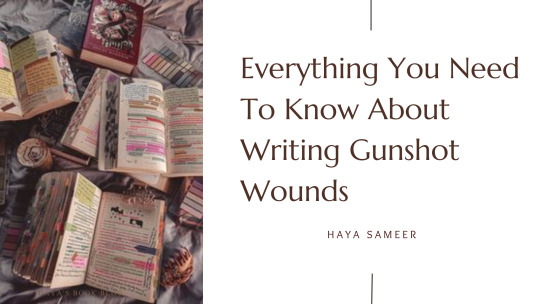
Welcome to the latest installment in my ongoing series on crafting realistic wounds in fiction! After covering stab wounds and burns, it's time to explore the next wound category frequently explored in fiction—gunshot wounds.
Gunshot wounds are a recurring motif in the realm of storytelling. They're something you can easily come across in every genre, however, authors often poorly portray gunshot wounds due to lack of proper research. I understand finding the right resources to aid with your writing can be hard, so here's my comprehensive guide on how to write gunshot wounds.
How To Categorise Gunshot Wounds
There are certain factors you need to consider before writing a gunshot wound. These details are instrumental in crafting a vivid and plausible narrative while avoiding plot holes. The first and most important one is identifying the type of firearm used to inflict the wound.
Picking The Right Firearm
Selecting the appropriate firearm to inflict a gunshot wound is a pivotal decision. It's not just about choosing any gun; it's about picking the right one to align with your desired outcome and the narrative's overall impact. Here's a quick guide on how to pick the right firearm.
The Impact of Firearm Selection
The firearm you choose can significantly influence the severity and appearance of the gunshot wound. Whether your goal is a graphic, gory injury or a precise, long-range shot, the choice of firearm plays a crucial role. Here are some guns you to consider:
Handguns: These are versatile and commonly used in close-quarters combat. They can result in gruesome, close-contact wounds with a higher potential for damage due to their stopping power.
Shotguns: Shotguns disperse shot pellets upon firing, making them suitable for creating a broader pattern of injuries. If you aim to depict a devastating, close-range gunshot wound, shotguns can be a fitting choice.
Rifles: Rifles are known for their accuracy at longer distances. When you need a precise, long-range shot, rifles are the go-to option. They tend to produce a cleaner wound channel, especially when used for a targeted, well-planned injury.
Choosing the Right Firearm for Your Narrative
The type of firearm you select should align with your story's objectives. If you intend to evoke visceral, gory reactions, opt for handguns or shotguns used in close proximity. On the other hand, if precision and long-range engagement are key, rifles can achieve your desired outcome.
Keep in mind that firearm selection can affect the wound's damage, trajectory, and overall portrayal in your narrative.
Categorising The Wound
Once you've identified the type of firearm, you need to establish what type of wound your character will incur.
In order to bring your character's injuries to life, it's important to first identify what you're dealing with. You can do this by categorising the injury based on several factors. For gunshot wounds, this includes the type of firearm used, the bullet's trajectory, and the specific areas of the body affected.
You can categorise your character's gunshot would into seven main categories, here's a quick breakdown of what these categories look like and the level of severity associated with them:
Penetrating Gunshot Wounds: These wounds occur when a bullet enters the body but doesn't exit. The bullet remains inside the body, causing damage along its path.
Perforating Gunshot Wounds: In this case, the bullet enters the body and exits on the opposite side. This type of wound can have a different set of implications due to the bullet's trajectory.
Ricochet Gunshot Wounds: Ricochet wounds happen when the bullet bounces off a surface before hitting the character. The nature of the surface can influence the severity of the wound.
Through-and-Through Gunshot Wounds: As the name suggests, these wounds occur when the bullet enters one side of the body and exits through the other. The trajectory can greatly affect the injury's severity.
Close-Contact Gunshot Wounds: These wounds result from the firearm being fired at extremely close range. The proximity of the gun to the body can lead to unique wound patterns and burn injuries.
Shotgun Wounds: Shotgun wounds differ from those caused by handguns or rifles. The shot pellets disperse upon firing, leading to a broader pattern of injury.
Long-Range Gunshot Wounds: When a character is shot from a considerable distance, the wound might appear different due to factors like bullet tumbling and loss of velocity.
The Anatomy of a Gunshot Wound
To create a vivid portrayal of a gunshot wound, writers need to grasp not only the external appearance but also the internal effects it has on the body. A well-executed description captures both the physical trauma and the emotional turmoil experienced by the character. Here are some symptoms you should take into consideration.
1. External Appearance and Bleeding:
Wound Size: The size of a gunshot wound can vary significantly based on the type of firearm and bullet used. Smaller calibers may leave entry and exit wounds that are relatively small, while larger bullets or high-velocity rounds can create much larger wounds. Be specific about the size, which can help readers visualize the injury.
Blood Loss: Gunshot wounds typically result in bleeding. The severity of bleeding depends on factors like the wound's location, the size of the blood vessels damaged, and the bullet's trajectory. Mention the amount of blood, but avoid excessive gore unless it serves a specific purpose in your narrative.
Coughing Up Blood: If the gunshot wound affects the chest or lung area, characters may cough up blood. This symptom often signifies a more critical injury and can add drama to your story.
2. Internal Damage and Symptoms:
Pain: Gunshot wounds are painful, and the character should express this pain through their actions, dialogue, and internal thoughts. Describe the sharp, burning, or throbbing sensations as they resonate through the character's body.
Shock: Depending on the severity of the wound, shock can set in. The character may appear pale, sweaty, and disoriented. This state of shock can impact their actions and decisions.
Loss of Function: A gunshot wound may impair the use of the injured body part. Describe any loss of function, such as the inability to move a limb or use it effectively.
Fainting: In extreme cases, characters may faint due to the pain, blood loss, or shock. Be sure to contextualize this within the narrative, as fainting can have significant consequences for the character.
By diving into the details of a gunshot wound's anatomy, you can craft a compelling and realistic portrayal that draws readers into the character's harrowing experience. I haven't exactly covered every symptom out there, but these are the major ones you should take into account when writing.
Medical Assessment and Treatment
Once you've established your gunshot wound, it's now time to focus on the aftermath. One of the main factors to consider is the medical process that follows. If your character is supposed to die from the gunshot then you could probably skip this section, but if they're alive here are things you need to consider.
1. Initial Assessment:
Scene Safety: In a real-life scenario, safety is paramount. First responders will ensure the scene is secure before approaching the injured person. Consider factors like the presence of firearms, potential threats, and the safety of medical personnel.
ABCs of Assessment: Medical professionals follow the ABCs—Airway, Breathing, and Circulation. Writers can reflect this in their storytelling by highlighting the character's ability to breathe, cough, or speak after being shot.
Vital Signs: Mentioning vital signs like heart rate, blood pressure, and oxygen saturation can help convey the character's condition and the urgency of their medical treatment.
2. Trauma Assessment:
Focused Assessment: Medical personnel perform a thorough examination to identify the gunshot wound's location, entry and exit points, and any associated injuries. This assessment informs their treatment plan.
Imaging: Depending on the complexity of the injury, X-rays or other imaging may be required to visualize the bullet's trajectory and any potential damage to internal organs or bones.
3. Treatment:
Bleeding Control: Stopping the bleeding is a top priority. This may involve applying pressure, packing the wound, or even tourniquet application in extreme cases.
Wound Care: Depending on the wound's severity, cleaning and suturing may be required. The character's response to this procedure can add an element of realism to your narrative.
Pain Management: Gunshot wounds are excruciatingly painful, and medical personnel will often administer pain relief or anesthesia during treatment.
Monitoring and Observation: Patients with gunshot wounds require careful observation and monitoring for signs of infection, complications, or changes in their condition.
By accurately portraying the medical assessment and treatment of gunshot wounds, you not only enhance the authenticity of your writing but also depict the physical and emotional toll such injuries can take on your characters. This attention to detail helps your readers connect more deeply with the story.
The Psychological Impact
Gunshot wounds don't just inflict physical harm; they also leave lasting emotional and psychological scars. It is important to note that the extent of the psychological impact on your characters will heavily rely on various factors.
For example, you need to consider whether or not this injury is something normal for them. Do they work as a spy, assassin, or other such roles that would mandate such dangerous injuries? You also need to consider who shot them. Does this wound come with emotional damage as well? Think of Aaron Warner’s reaction to Juliet shooting him.
If you’re sure your character will have some extent of a psychological impact, here are some factors you should consider.
1. Shock and Denial:
Immediate Response: Characters who have been shot may initially experience shock and denial. This can manifest as disbelief, emotional numbness, or a surreal sense of detachment from the situation.
Physical Symptoms: Shock can lead to physical symptoms like trembling, chills, or even fainting. Incorporating these details can make the character's reaction more genuine.
2. Fear and Anxiety:
Survivor's Guilt: Characters may grapple with survivor's guilt if they are the only ones to emerge unscathed in a violent encounter.
Anxiety: The threat of recurrence or the fear of returning to the location where the shooting occurred can trigger anxiety and panic attacks.
3. Post-Traumatic Stress Disorder (PTSD):
Flashbacks and Nightmares: Characters who have survived a gunshot wound may experience recurring flashbacks and nightmares, vividly reliving the traumatic event.
Hypervigilance: PTSD can lead to hypervigilance, where characters are constantly on edge, expecting danger at every turn.
4. Depression and Isolation:
Emotional Withdrawal: Characters may withdraw from social interactions, experiencing feelings of isolation and sadness.
Emotional Numbness: Some may describe feeling emotionally numb, unable to experience joy or pleasure.
5. Recovery and Resilience:
Therapeutic Support: In your storytelling, consider how characters seek therapy or counseling to cope with their emotional scars. Therapy can be a path toward recovery and resilience.
By addressing the psychological impact of gunshot wounds on your characters, you create more layered and relatable individuals within your narrative. This depth allows readers to connect with the characters on a profound emotional level.
I hope this blog on Everything You Need To Know About Writing Gunshot Wounds will help you in your writing journey. Be sure to comment any tips of your own to help your fellow authors prosper, and follow my blog for new blog updates every Monday and Thursday.
Looking For More Writing Tips And Tricks?
Are you an author looking for writing tips and tricks to better your manuscript? Or do you want to learn about how to get a literary agent, get published and properly market your book? Consider checking out the rest of Haya’s book blog where I post writing and publishing tips for authors every Monday and Thursday! And don’t forget to head over to my TikTok and Instagram profiles @hayatheauthor to learn more about my WIP and writing journey!
#hayatheauthor#haya's book blog#haya blogs#writers on tumblr#writer community#writer tools#writer blog#writer stuff#writer wednesday#writer tips#creative writing#writers of tumblr#writerscommunity#writeblr#writing community#writer spotlight#writer things#writing prompt#writing tools#writing stuff#writing#writing life#writing inspo#writing help#writing advice#writing inspiration#writing ideas#writing things#writing tip#quillology with haya
2K notes
·
View notes
Text
Inquisitor Women in Star Wars: a 2024 Summary
while women are underrepresented in the Sith order, the Inquisitorius is quite an egalitarian organization :) let's sum up what we know about these lovely ladies
(spoilers for everything concerning inquisitor characters, including the manner of their death)
2. Second Sister aka Trilla Suduri


Padawan to Cere Junda at the time of Order 66
captured and tortured into joining the Inquisitorius shortly after
dies 5 years later, executed by Vader for her perceived failure
human; age unknown, I'd estimate late teens to mid-twenties at the time of recruitment
created for Jedi: Fallen Order (2019), appeared before the game's release as a cameo in Darth Vader 2017 issue 19 (2018) and as a main character in the game tie-in miniseries Dark Temple. mentioned in Rise of the Red Blade (2023).
ambitious, relentless, a good slicer. wears a full helmet all the time when on the job.
3. Third Sister aka Reva Sevander
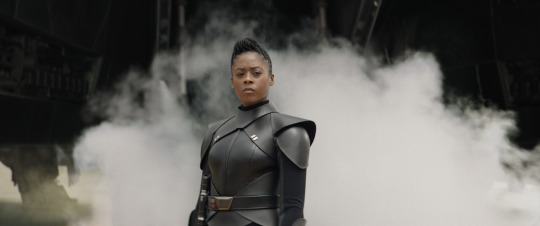
12-year-old human youngling at the time of Order 66
joined the organization voluntarily and while hiding her identity, at an unspecified point a relatively short time before 10 years post-Order 66
left the Inquisitorius 10 years after Order 66, after failing to kill Darth Vader and being left to die
created for Obi-Wan Kenobi (2022). not in RotRB, likely due to not yet being a member during the book's timeline. does not appear and isn't mentioned in other canon material, outside of OWK's comic adaptation.
spent 10 years single-mindedly pursuing her goal of revenge. very intense and ambitious. youngest recruit we know of and the only one to have at least a quasi-canon number duplicate (the Third Brother).
4. Fourth Sister aka Lyn Rakish
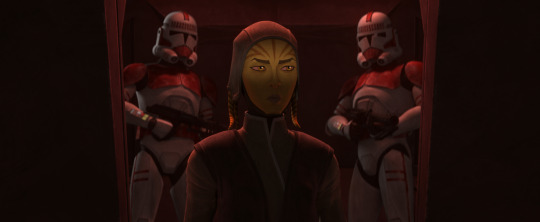
joined the Inquisitorius around the time of Order 66, apparently of her own free will
species, age and rank at that point unknown, may have been a peer of Barriss or somewhat older
left the Inquisitorius after serving it for over 15 years (actual time unknown but less than 20 years)
created for Obi-Wan Kenobi (2022), part of the main cast in Tales of the Empire (2024), mentioned in RotRB (2023).
dedicated to the organization, pragmatic and better at cooperation than most colleagues.
7. Seventh Sister

joined the Inquisitorius shortly after Order 66, and appears to have been tortured into it
mirialan; age and rank before recruitment unknown, implied she may have been a peer of Aayla Secura or younger
killed in action after serving the Inquisitorius for 16 years
created for Rebels s2 (2015), a minor character with several scenes in Darth Vader 2017, RotRB (2023) and the Inquisitors comic miniseries (2024)
only one on the list without a known name. snarky and flirty with targets. strained relationship with multiple coworkers.
9. Ninth Sister aka Masana Tide
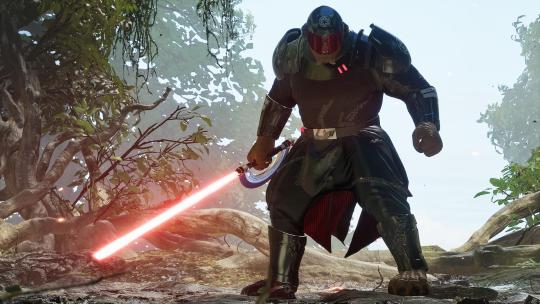
Dowutin, age unknown and hard to estimate
joined the Inquisitorius involuntarily shortly after Order 66, through torture and mutilation
dies 10 years later, killed by her target
created for Darth Vader (2017) as a recurring character. part of the main cast in Jedi: Fallen Order (2019), shows up in Jedi: Survivor (2023), has a part in RotRB (2023) and Inquisitors (2024).
best empath of the Inquisitorius. snarky and jovial even with Darth Vader. very traumatized. keeps losing body parts.
13. Thirteenth Sister aka Iskat Akaris
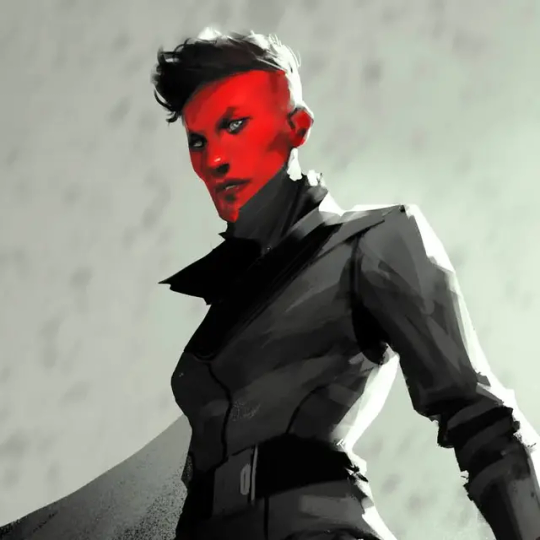

joined voluntarily after flirting with the dark side for years and being groomed by Palpatine
21-year-old Knight at the time, pkorian (species created for her)
killed 5 years after joining by Vader for perceived disloyalty
created for Darth Vader 2017 issue 19 (2018), main character of novel Rise of the Red Blade (2023)
only inquisitor to have a boyfriend in canon. has a helmet she wears on missions but is pretty laid back about it. only gets her inquisitor name a while into her tenure, so her birth name is known to others.
+ Barriss Offee
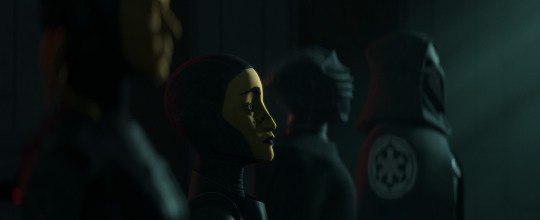
former Jedi in Republic prison at the time of joining
agreed to get recruited a short while after Order 66, but left on her first mission after learning more about the organization, never got a proper inquisitor title
mirialan; age unknown but is around the age or slightly older than Ahsoka, 17 year old at the time; would have been 21 according to a non-canon reference book
has existed since 2002 as a background character in the prequels and their now non-canon tie-in novels, her short-lived inquisitor iteration was long rumored and introduced in Tales of the Empire (2024).
#inquisitorius#trilla suduri#reva sevander#lyn rakish#seventh sister#masana tide#iskat akaris#barriss offee#star wars inquisitors
69 notes
·
View notes
Note
Okay you got me. Tell me about PP 1980
Okay, so XD
Imagine you had a BBC adaptation of Pride and Prejudice that was 5 hours long, faithful to the book, and yet having a different perspective/understanding/interpretation of the characters and the story? That's P&P 1980 in a nutshell, and I think it is worth watching just for that. But here are some other concrete things it has going for it, specially in relation to other adaptations:
The casting is closer in age than 95, and on one specific important case, closer than 05 too: Lady Catherine de Bourgh is played by an actress in her mid 40s, and she nails the absolute Opinionated Facebook AuntTM thing that the character has going in the novel.
It's not the only case of closer accuracy to the book in characters: Mr Collins is a young, tall, big guy, whose main issue is being very small minded, petty, and obsequent, instead of recurring to "he's greasy or slimy" as other adaptations do.
If you agree/like the "Darcy has autism" headcanon, this is the adaptation that leans the most heavily into it (it does overdo it, in my opinion, but there's a very interesting contrast between the flat affect of his facial expression, and the richness of inflexion in his voice)
Elizabeth Garvie's Lizzy is just... extraordinary. This adaptation circumvents the Jane-as-prettier-than-Lizzy issue by casting as Lizzy an actress with big, dark, very expressive eyes, small features and a very lively, sharp countenance and manners, whereas Jane's actress is tall and graceful and has a general air of kindness and sweetness, but in a very youthful way.
Speaking of Jane, this adaptation focuses much more on the sisters as sisters, and gives special emphasis to Lizzy's love for Jane, which I appreciate a lot.
Also speaking of Jane, Jane and Bingley are the cutest in this. They are given time, and he's kind and sociable and sweet without being an idiot. This adaptation includes that great line of his about how he wouldn't mind Darcy so much if he wasn't so tall, and the following comment about how Darcy can be fastidious of a Sunday evening.
That way, this adaptation includes several fan favorite scenes/lines that don't usually make it to adaptation, such as Darcy asking Lizzy to dance a reel, Lizzy playing and singing at a party in Meryton, Caroline teasing Darcy about putting uncle and aunt Phillips on the Pemberley portrait gallery, and the "I cannot fix the hour or the spot..." line. EDIT: also, the coffee pot scene!! and the rivalry between Mrs Bennet and Lady Lucas!
I also think it balances well how awful, in different ways, both Mr and Mrs Bennet (EDIT: and she's not insufferably shrill!!!!) are as parents (unlike how 95 and 05 "pick sides"); it emphasizes how self centered her efforts are, and how lazy and callous he can be in his mockery and indolence.
The opening sequence of each episode is a roll of a hand-drawn summary of the events of the episode and that's such a lovely detail.
Mind you, the adaptation is not without its faults. The production values are not what we are accustomed to nowadays. Some acting and lines are stilted and/or awkward. It has the odd choice here and there that is involuntarily funny. But I don't think people need discouragement from seeing it. I don't even think most of the general Austen fandom is aware of its existence. For my part, it has become my favorite adaptation of P&P (that I have watched so far; I haven't gotten yet to either 1967 or the Italian one).
252 notes
·
View notes
Text
Writer Interview
Tagged by @my-favourite-zhent nearly 3 weeks ago and I've entirely missed the wave.
I've enjoyed reading so many interesting ones by my mutuals! Tagging (only if you're keen) @graysparrowao3 @coreene @say-lene @luvwich @grossestjay —and if I've missed your interview somehow, tag me in the comments!
Q&A after the cut—
When did you start writing?
I wrote my first fanwork at age 12. It was self-insert fanfiction with me and 2 of my friends in the Slayers anime universe, which meant it was several comedic sketches strung together with with lots of actions denoted by asterisks and emoticons. You know the ones ^_^ ^____^ @_@ T_T *slaps you gently with a trout*
We printed it out on someone's home printer and bound copies in plastic school folders with a two-hole punch. I've lost the original file ages ago, but I would love to read it again.
Are there different themes or genres you enjoy reading than what you write?
When I was younger, I actively sought out "difficult stories" because I wanted to experience things beyond my day to day life. I read Nabokov at 16 because everyone kept saying Lolita was a dangerous book. I also read a lot of Chuck Palahniuk and Bret Easton Ellis without really understanding them.
My pretentiousness definitely peaked in my university days. My dating profile at the time listed: Herman Hesse, Kazuo Ishiguro and Mikhail Bulgakov.
Now that I'm older, I read and write stories primarily to make myself happy.
Is there a writer you want to emulate or get compared to often?
I'm not remotely at the level where I get compared to any published writers.
My favourite contemporary writer is David Mitchell (of Cloud Atlas fame), and my favourite book by him is The Thousand Autumns of Jacob de Zoet.
My favourite "classic" novel is The Left Hand of Darkness by Ursula K. Le Guin.
Can you tell me a bit about your writing space?
I type at my desk, in a study shared with my partner. Sometimes if the scene is particularly spicy or they are gaming too loudly, I take the laptop to the living room.
What's your most effective way to muster up a muse?
Bouncing plot bunnies off others on Discord, talking a walk or a long train ride, playing an immersive video game and rotating characters in my head for hours afterwards.
Are there any recurring themes in your writing? Do they surprise you?
According to my lovely readers:
"Romantic and sweaty"; "two silly sausages frying in a pan" (thanks to my long time beta-reader @littleplasticrat)
"Purity, temperance, glimpse of [the] ability for real love / real forgiveness" (thank you @tellmeallaboutit!)
These did surprise me a bit when they were first pointed out but it makes sense—I've been accidentally writing Regency romances and repressed idiots in love without setting out to do so explicitly.
What is your reason for writing?
I put aside hobbies for many years because of my work (no matter what advertisers want you to believe—doomscrolling is not a hobby). Started doing more creative things during my sabbatical last year, and writing was one of the things that saved my broken corpo soul.
Nowadays I'm really into bread making and cooking in general. I'm trying to balance work and creative pursuits and I'm much happier overall.
Is there any specific comment or type of comment you find particularly motivating?
Any and all comments are received with love <3 <3 <3 I really enjoy it when people let me know what lines really resonated with them or point out motifs I'd snuck in.
How do you want to be thought about by your readers?
Friendly and approachable! Not entirely hyperfixated on That One NPC from a Video Game with Five Lines (that one might be harder now...!)
What do you feel is your greatest strength as a writer?
A fairly broad vocabulary, including anachronisms, which is useful for fantasy story settings. Writing characters who are actively lying to themselves (thinking one thing and saying/doing another).
My writing tends to be on the more contemplative side and a bit sadder and slower paced, so if you enjoy A Great Deal of Yearning along with your smut, then it would appeal to you :)
How do you feel about your own writing?
I'm pretty happy with it! I write very, very slowly, with constant edits as I go, and would probably starve if I ever had to rely on my fiction writing to be paid. Luckily, I get to do this as a hobby.
When you write, are you influenced by what others might enjoy reading, or do you write purely for yourself, or a mix of both?
I write for myself, but I am also super blessed to have a very small but vocal audience that I can interact with directly. I guess my best advice is: Write for yourself and your 10 friends who want to read your hand-bound home-printed self-insert fanfic <3
28 notes
·
View notes
Text
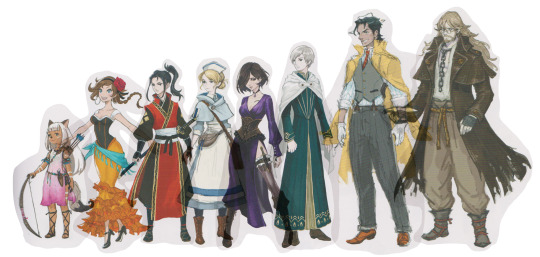
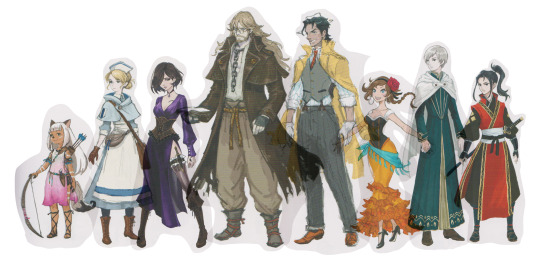
As promised, the theory heights of the Octo2 crew based on my best guess from the official arts. These are not canon heights (or headcanon heights), they're my best theory for the general heights the art team was using based on recurring heights in official arts.
I used several official arts, but this was the main art I used for ref:
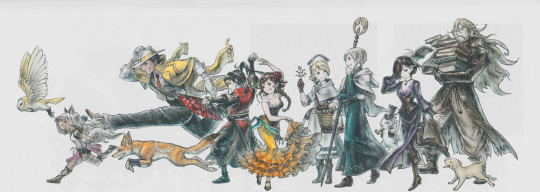
This is (currently) the only official art where all the characters are standing more or less on the same plane, without being too far in front of or behind others. Also they're spaced out nicely, which made sketching mockups of their proportions much easier.
I also went ahead and threw my lineup onto an actual height chart (US system, sorry) to try and guess at their heights, and got...these:

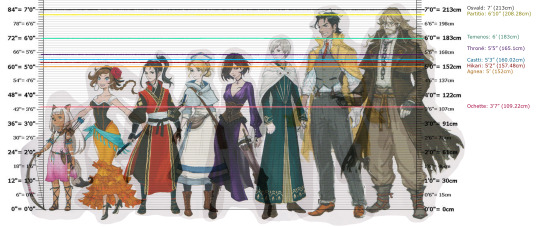
Again, these are super not canon (or headcanon), and even for theory territory this falls more into the wild speculation side of things. But this was my best guess, since placing Osvald in the 6' range made Agnea and Hikari way too short. Ochette is a beastling, and as far as I can tell they have a different set of proportions as well as anatomy, so I'm assuming her smallness (which is very consistent in official arts) is intentional on the art team's part.
(I also didn't include Ochette's ears in her height estimate, but it should be noted that while I used the concept arts from the artbook bc they provided the most consistent "character is standing in an upright pose" artwork, Ochette's ears are actually a bit larger in all official non-concept artwork).
Anyhow, I also included my entire process for how I extrapolated under the cut. As a treat.

So I started with the main art I showed above and drew out quick mockups measuring each character from the top of their head to bottom of heel, not counting heels on shoes. For characters in dynamic poses, I sketched out a quick "puppet" using major anatomical points (head, torso, hips, knees, heel) as guidepoints, which I then "straightened out" separately to figure out the "height" (as seen with Ochette, Partitio, Hikari, and Throne; I forgot to save a copy of my Osvald sketchover but since his stance was so wide I knew he was going to loose a bit of height if I didn't sketch a puppet).
Agnea is mostly upright, but she's leaned forward a bit, and I wasn't going to be able to figure out how tall she was if she wasn't leaning forward with a puppet, so I gave her a bit of height in her mockup using my best guess as an artist for where the top of her head would be if she wasn't leaning forward. I took the same liberty with Hikari after straghtening out his sketch-puppet, since he's also leaning a bit forward. I couldn't actually see the bottom of either of Partitio's heels, so I went with my best "I'm an artist how would I have drawn this" educated guess.
Then I grabbed images of the concept artwork from the artbook scans (special thanks to @octopathartbooker for the scans) and adjusted each character to the mockup, and then put all the mockups so that the bottom "heel-line" was level for every character, getting this:
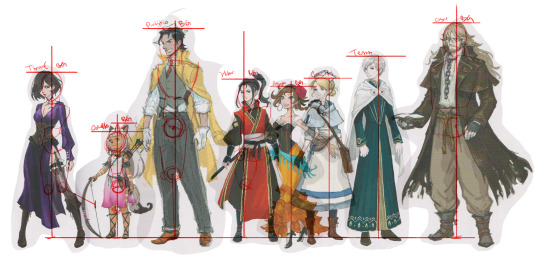
Note that Throne is in a wide stance for her concept art but that I still scaled her to the mockup for ease of visual reference (even though as I've scaled the art, it looks like she'd be taller if she were to stand upright, but I needed the visual more than I needed the pose accuracy). I also ignored the position of Agnea's foot in favor of having her heel on the heel-line, so she looks kind of awkward. These things happen, but considering how a few of the heights bounce around a tiny bit in official arts, I think this is the best I could do.
Because a few of the heights just...didn't look right (Partitio being that tall, and Ochette being that small) I also referenced a few other key official arts. First off, the "thank you" art:
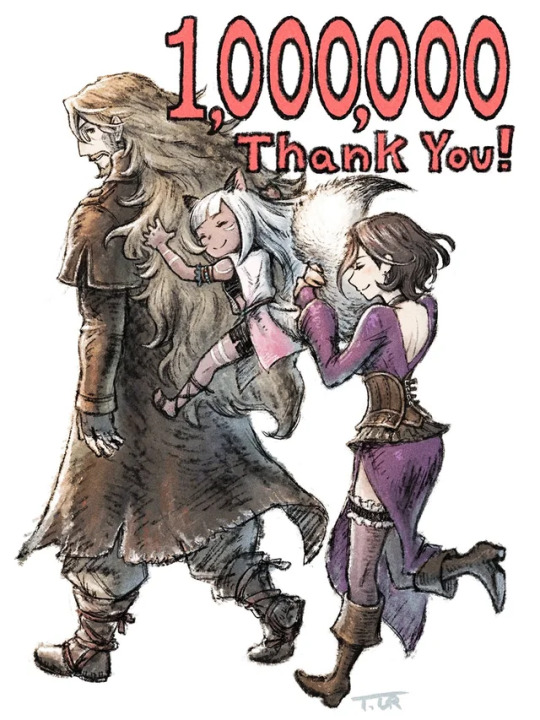
This was useful for checking Throne's height against Osvald, since if I were to draw perspective lines then the top of Throne's head would be about level with Osvald's shoulders. This art also shows Ochette as being about half Throne's height, which is also consistent with my mockups.
I also checked the "nighttime" artwork for the soundtrack:
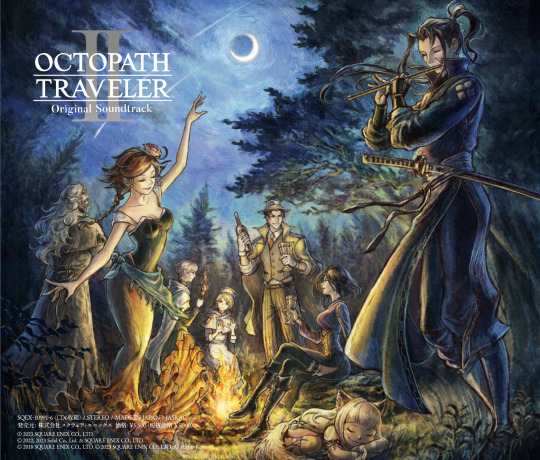
This art isn't actually as useful given how much perspective depth is used in the illustration (Agnea looking taller than Osvald bc she's in the midground and he's in the background being a good example of the depth I'm referring to), but it does show Ochette next to Hikari, and again, she is small. Also Partitio towering in the background supports the idea that he's actually just like, really tall.
The final official art I used to check heights was the endgame artwork, which is naturally a huge spoiler, so go ahead and skip this if you don't want to see it, bc aside from my notes on the artwork there isn't anything after it. (J is the hotkey that'll let you skip to the bottom of a post, though I dunno how this'll look if you're on mobile, sorry).
.
.
.
.
.
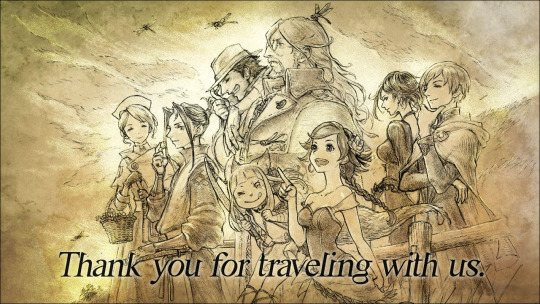
This art is...somewhat helpful. I can't see anyone's feet and Ochette appears to be floating (although again, she is tiny compared to everyone else), and there's still some depth of perspective at play, and some of the characters look like they're standing on a higher elevation than others. But! Here we can see that yeah, Partitio is about as tall as Osvald and that's with his head leaning forward (tall enough to use Osvald as an armrest, Parti buddy). Agnea also looks like she could be about two feet shorter than Osvald and this art does nothing to suggest that Hikari isn't short, but again it's hard to tell with some of the perspective choices. Mostly this the art that convinced me that, okay, yes, Partitio is that tall.
#octopath traveler#octopath traveler 2#octopath ii#HERE IT IS#this theory project consumed my interest out of nowhere for two days#don't take the height chart w/ measurements on it too seriously#I honestly don't think the art team has official heights for the characters#bc I don't think they would have chosen those heights if they did#mostly I just think that they had a general ''this is how tall everyone is'' to use for ref#but like there's a LOT of artistic liscence in all the official arts so like again#this is a theory and not canon and also not headcanon bc these are not the heights I'd have chosen if I was just making up headcanons#oracle of lore
149 notes
·
View notes
Text
Until Dawn updated headcanons: + Unlife is Strange/Screaming Until Dawn
The following headcanons are included in my AO3 stories; Unlife is Strange and Screaming Until Dawn. Both fics are part of the same “verse”.

Much of these were written down before the remake allowed us to save Josh. Because of this, Josh becoming the Makkapitew’s new host is canon as far as this “verse” is concerned.
Grab your popcorn. This is whole world building.
1. First things first, this bit was something taught to me growing up about the wendigo. I’m not sure if it’s a widespread belief or a regional/local one — especially since details vary between bands and regions.
Anyways what I was taught was that if you kill a wendigo without taking the right “precautions” — either burning their heart or cutting up their body and burying them at different locations — their spirit will fixate on you and actively haunt you out of revenge.

They will always know where you are and everything about you; your name, family, home; your fears and weaknesses; and they will use you against you. And there’s nowhere you can run where it won’t eventually follow. There's nowhere you can hide that they don't already know.
Enter the Makkapitew, an already powerful and vicious wendigo spirit which has possessed two people with grudges against the cast. Because of this, it holds a special grudge. Simply killing them just isn't gonna cut it. It's especially fixated on Sam, for so close to Josh and Hannah, and being the one who set off the explosion that killed it.
Following the events of “They All Live”, the Makkapitew spirit soon followed them from the Blackwood Pines and became a regular supernatural nemesis in their lives; either as a spirit or through Josh’s body. Sometimes the Makkapitew is a genuine threat or menace, other times it’s a petty annoyance out to ruin their day.
It’s like Eobard Thawne that way.
youtube
In it’s first rampage the Makkapitew tracked them down to their hometown, and slaughtered several of their friends, neighbors and family members. Sam tried to reach out to “Josh”, and got non lethally mauled for her trouble — Sam has a few bite/scratch scars on her stomach, side, calf and thigh that haven’t quite faded.
After this, everyone save for Chris and Ashley came to believe Josh is well and truly gone.
2. Crossover Headcanon: Following the initial massacre, “The Blackwood Seven” are reached out to by the FBC (Control).
They are ultimately put into a witness protection sort of deal, with one of the catches being they’d do “Scout Work”; being civilian eyes and ears on a few ongoing cases. They were assigned to the Arcadia Bay case, soon befriending characters like Max, Chloe, Kate, Victoria and the vampiric Rachel Amber.

They soon become field agents, but during Screaming (set in October of 2016), Sam is taking a sabbatical to focus on college. Because of their involvement, the UD cast are recurring/supporting characters in Unlife is Strange; and the LIS characters are recurring/supporting characters in Screaming Until Dawn.
At the time of Screaming, Mike and Matt are taking an overseas assignment — something about containing a vampire nest in Iraq that was discovered in 2003, and now starting to leak; while Emily was coming back from working off the coast of Japan, looking into and covering up sightings of a “sea dragon” near Odo Island.
She brought with her pictures that would make Nessie/Champ enthusiasts “Mess their pants.”
3. Following the events of “They All Live” Josh is thrown under the bus by law enforcement and the media.
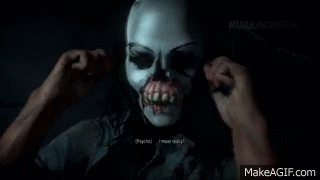
With the wendigo having been covered up during the investigation, the FBC and RCMP compiled all available evidence, which ultimately points at Josh as being a wannabe cannibal serial killer; going as far as to implicate him as being behind Hannah and Beth’s disappearance, with armchair psycho-analysts painting him as having an incestuous fixation on them.
The nail in the coffin against him was Josh’s teeth marks and DNA found on the cops he slaughtered, and on Sam after her attack; Jack’s severed head, Beth’s severed head; a shrine for his sisters; and the traps he set up throughout the lodge; videos recordings of Ashley and Chris being caught in these traps; and Sam taking her bath. For this Josh was labeled as an inhuman monster by the public, and his parents disappeared from the public. As a result, Bob’s Hollywood career is up in smoke.
His friends could try to speak out for Josh’s favor, but were coerced into going along with the narrative by Director Zachariah Trench; who pointed out to Sam that publicly defending the guy who recorded her bathing, drugged her and physically assaulted her, is not a good look. He gave the same kind of lecture to Chris and Ashley, pointing out how they were the only other two personally victimized by Josh.
As a result, the Blackwood Seven never speak about the case publicly, only talking about it to a select few friends who they trust with the truth.
It’s because of this, most of Josh’s friends write him off as truly being gone after his possession. If there was a way to bring him back, it’s not like he had much of a life waiting for him. As another result, Josh’s case is often publicly compared to that of Mark Jefferson Nathan Prescott, due to the events of LIS occurring not too long before Hannah and Beth disappeared.
The comparisons are usually made by those overly sympathetic to Nathan, and overly demonize Josh. Ironically it’s because of these comparisons, the Blackwood Seven were assigned to the Arcadia Bay investigation.


Much of Screaming is gonna deal with the fallout of what happened to the Washingtons.
4. Shipping/sexuality headcanons: I write Jessica, Emily, Mike and Matt as being bisexual, and Sam as a lesbian.
Mike is still coming to terms with his bisexuality, which is ironic because he’s normally supportive of his bi/gay friends. At the time of Screaming, Jess and Emily have been trying to pair Mike and Matt up for a whole now, often pulling strings to get the Bureau to put them on field missions together.

While Sam isn’t dating dating anyone, as of this post has a regular “Friends With Benefits relationship with Emily and Jessica, though it’s transparent their actual feelings are more than platonic. But following the events of UD, Sam took up a habit of casual flings and hookups as trauma cope.
She usually keeps it to consenting sapphic friends in her inner circle, with boundaries in place; mainly friends she made from Arcadia Bay. But her heart goes to Jessica and Emily. Sam, Jess and Emily are the main OT3 of Screaming Until Dawn. One of the inciting incidents is that the three are planning a “Girl’s Trip” together.

5. In this setting, Jack/The Stranger is not related to Jack Fiddler. While I’m not opposed to the Famous Relative/Ancestor trope, knowing the IRL history of Jack Fiddler, it was waaay too touchy. It helps that it’s not something explicitly mentioned in the game, therefore can be overlooked.
Here, Jack is a member of the Dibikad family, a minor but recurring Oji-Cree family I feature in my stories, and the last of the Pâhkwêkan (Night Owls) — a party of vampire/werewolf hunters formed during the Colonial era.
Their backstory goes that there was a vampire that lived in the Great Lakes Region for centuries, historically thought to be a Viking settler. For the most part, he was benign and left the natives alone, but when settlers started colonizing the Americas, they brought with them vampires and werewolves.

This “Viking settler” began teaching the natives about these creatures and their weaknesses. The Pâhkwêkan was soon formed from these teachings. Unfortunately, the Pâhkwêkan were so effective in dealing with vampires and werewolves among the settlers, that Colonists used their “raids” as an excuse to really crack down on the natives.
By the 1890’s, the Pâhkwêkan were down to one faction in Alberta. By then, a young and overzealous Pâhkwêkan hunter named Maxwell Dibikad led a raid in Blackwood Forest; erroneously coming to believe that wendigo were a type of vampire. As recompense, the Makkapitew slaughtered all but Maxwell, who was left crippled and forced to disband the Pâhkwêkan lest it returns continuously for his family and community.
In the present day, the Dibikads' want nothing to do with the Pâhkwêkan save for Jack, and his niece Vanessa - another recurring character in Unlife, who became handler to the Blackwell Seven.
6. In Screaming Until Dawn, Sam is sort of an alternate counter to Kirby Reed. Their connection is gradually revealed when they experience glimpses of each other’s lives as “dreams.” In 2011, Sam has a dream of being Kirby during Scream 4; and in 2015, Kirby dreams of the events of Until Dawn from Sam’s perspective.
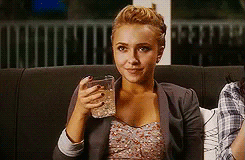
For much of the story, Sam and Kirby are gonna be seeing/experiencing more of their lives through each other’s eyes; starting when Sam gets calls from a Ghostface repeatedly calling her “Kirby”, and is now targeting her friends; and Kirby repeatedly being followed a presence calling her “Sam”.
I also considered giving also Jessica some ties to Scream characters, but I haven’t made any final decision on that.

Gif unrelated.
I also had a joke in mind where Mike similarly “dreamt” of being the MCU’s Grant Ward. Somewhere in the multiverse, Ward dreamt of being Mike.
7. Since Bob Washington was a Hollywood director, Screaming Until Dawn includes one of his most popular movies. It’s not plot relevant or anything, but there for world building and a running gag.
In 2002, Bob directed a horror/fantasy swashbuckling movie called Wittebane — based on the Connecticut folk legends of two witch hunting brothers. It’s not the first adaptation of the legend, but it was one of the more popular ones, for its subversiveness and its love story.
The movie put a romantic spin on one of the brothers, Caleb (Ben Affleck) and the witch Evelyn (Winona Ryder); and the brother Phillip (Mark Whalberg) being an outright villain were most adaptations portray him as a tragic failure protagonist at best.

It was released by Disney and considered one of their riskier movies, like Pirates of the Caribbean or Haunted Mansion, it was one of those movies that are clearly written for a mature audience and given a PG-13 rating. But because it’s Disney, it’s marketed as a family film anyways, and a whole lot of kids bared witness to the eyebrow raising “waterfall scene”.
Said scene caused “childhood lesbian awakening” memes across early 2010’s Tumblr. Wittebane also had an award bait song called “The Piece of You (I Carry With Me)” sung by Michelle Branch. Basically an equivalent to “My Heart Will Go On” or “There You’ll Be”.

It was especially popular in the brothers hometown of Gravesfield, with there used to be yearly showings every Halloween. But after the events of Until Dawn and the controversy surrounding the Washington’s, it became a really heated debate of separating the art from the artist.
As it happens, when the Blackwood Seven and co were conscripted into the FBC, they learned that Wittebane's original writer was a supposed practicing witch, who disappeared and reappeared from a place called “the demon realm” as a teenager in the 90's.
The FBC seemingly had the writer's memory wiped, and have been trying to access that realm ever since.
8. Pretty big lore drop.
In Unlife is Strange, Mount Washington/Madahee was previously nicknamed as “Chepaiyikumik” (“Grave”), being thought of as a mass grave with a dark history. Much of that history is intentionally covered up and lost to time, to the point it was mostly forgotten about by the Colonial period.

Dating all the way back to “Fuck if I know BC” — estimated to be the time of giants, titans and the old gods — what would become Blackwood Pines was a hotspot “The Children of Ithaqua”. They were a cult that spanned across what would become North America and Eastern Eurasia, but has mostly reduced to a fractured memory.
In a semi-related fic, Loves Sacrifices — Ithaqua is one of the Greater Scope Villains. The “human” son and mediator to the King in Yellow, Ithaqua taught humanity to follow his example in decadence and vice. There’s also a UD cameo where a character makes contact with Ithaqua’s spirit, and witnesses Jessica’s rant at the cabin from Ithaqua’s perspective.
Ut’s also implied he taught early humanity the concept of colonization. When his father is slain, Ithaqua was bound to another world and cannot directly interact with this one. Through his cults practices, it’s believed many cultural taboos were formed — EG, “Hey, this evil shit is what Ithaqua and his followers practiced. Yeah, let’s NOT follow their example, kay-kay ?”
Ithaqua’s present followers exist by the 2010's, but are hardly the apocalyptic threat they were way back when. They exist under the guise of Christian based institutions, including prosperity gospel/quiverfull preachers and televangelists — obsessed with making money and “breeding prosperity.”
They don't really believe in Ithaqua as an actual entity anymore, and more of a concept to live under. But as of Until Dawn, they are keeping an eye out for the Blackwood Seven.

And they're not the only ones watching...
#until dawn#sam giddings#emily davis#jessica riley#mike munroe#matt taylor#josh washington#chris hartley#ashley brown#life is strange#control game#scream#max caulfield#chloe price#rachel amber#kate marsh#victoria chase#kirby reed#tatum riley#stu macher#samily#jessam#jemily#m squared#pricefield#amberprice#amberpricefield#chasemarsh#federal bureau of control
10 notes
·
View notes
Text
Writing tips: How to describe depression with body language
WARNING: may be triggering to some; not meant to diagnose, only as a tip for writing characters suffering with mental health issues
Depression is usually different for everyone, but there are several symptoms that can be expanded upon and explored. Everyone is familiar with the concept of depression, but there’s a lot of physical responses that are visible and can also help in show-don’t-tell writing.
1. Depressed mood: pretty self-explanatory. Downcast eyes, unfocused gaze, downturned lips, sluggish movements, slow or slurred speech
2. Anhedonia (loss of interest in pleasurable activities): your character may be wandering, turning down offers, wanting to do something relating to a hobby but being unable to start or concentrate, other people may notice lack of passion, listless eyes, numbness
3. Loss of appetite/Weight loss or gain: playing with food, not having the energy to cook meals, eating the same thing over and over again, skipping meals, forgetting to eat until stomach is rumbling, eating to fill metaphorical emptiness, eating out of boredom, snacking instead of cooking meals, visible changes in weight and/or strength
4. Insomnia/Hypersomnia: struggling to fall asleep, turning and turning in bed without finding a comfortable position, waking up several times at night and struggling to fall back asleep, depression naps (usually lasting several hours), being sluggish, bags and shadows under eyes, taut, sallow skin
5. Psychomotor retardation/agitation: slow speech and movements, very little movement, delayed answers and physical responses; OR bouncing legs, wringing hands, nail biting, quick replies, nervousness
6. Fatigue: breathlessness, tiredness, weak legs and muscles
7. Diminished concentration: can be shown through character’s hobby (blank page for a writer, rereading the same paragraph over and over again, unsatisfactory work etc.), muffled sounds in conversations, lessons/lectures/work, easily avoidable mistakes slipping past character’s eyes
8. Feelings of worthlessness or guilt: recurring deprecating/horrible comments about skills/appearance/behaviour etc.,
7. Recurrent thoughts of death/ideation: not going to get into it, pretty self-explanatory.
General behaviours:
Again, this changes from person to person. As a generalised theme, people suffering from depression have a hard time with daily tasks. Brushing teeth, showering, food shopping, cleaning, tidying up, chores etc.
Also, don’t say a character feels depressed. Depression often feels like apathy, boredom, frustration, and sometimes, very intense anguish and hopelessness. Imagine the range of human emotions as a line. Depression is a line parallel to that but much lower, more muffled. It feels like a bubble that muffles feelings and the world around someone. It feels like trudging through mud to complete the simplest tasks. You may slow down the pacing to help the reader see just how long and exhausting every little action is, place a lot of inactivity inbetween actions, staring at walls etc.
A character with depression may also have very low libido, with difficulty orgasming, not wanting sex but desiring intimacy, mind wandering during sex etc.
Meds and healing
Medication can take up to 6 weeks to start to show results. Side effects in those 6 weeks range from nausea to dizziness, fatigue, migraines, and most of all, a feeling of constant apathy. Emotions are either not felt or being felt much less. That includes hopelessness as much as joy, excitement, sadness etc.
After those 5-6 weeks, character may notice the range of their emotions is widening. They feel more, more often. They may cry at a touching scene in a film, laugh or suddenly feel hopeful or happy or excited about a small thing. It’s fleeting, but human emotions actually last very little time. Don’t jump into happiness. For many depressed people, healing looks more like feeling different emotions more frequently, having slightly more energy, having inspiration for a painting, a story, a walk in nature. Healing looks very subtle, it’s a continuous process.
#i have a psych degree#doesn’t mean i know all about it#because everyone’s different#writing#writing tips#writers on tumblr#creative writing#writing body language#body language#psychology#mental health writing#writing depression#show don't tell#fanfiction writer
72 notes
·
View notes
Text
TTRPG's in 2024

So compared to the last couple years of tabletop games with friends, we got a lot more game sessions in. A large part of that being my willingness to step into the role of Dungeon Master, and basically pushing my campaign for a large part of the year. We were also flexible in availability and the number of players per session. But I'll go into those details later when talking about specific campaigns.
The other big change this year is to do with the title of this post. This is not just a celebration of D&D play anymore. Our other recurring Game Master this year had us playing other types of Tabletop RPG, experimenting in different types of game rules and storytelling. This same GM introduced us to the Pokémon TTRPG a couple years back, but with the addition of Vampire the Masquerade this year, I felt it disingenuous not to acknowledge our variety in game systems in the title.
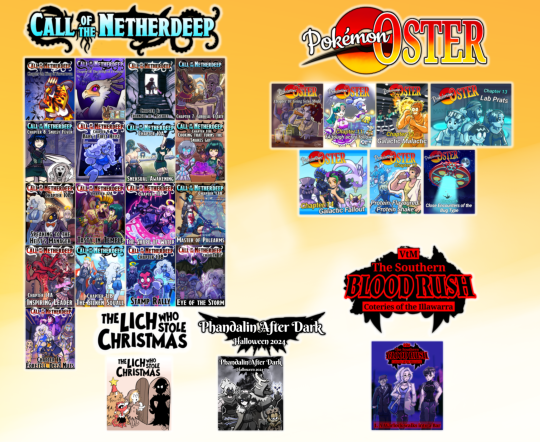
Here's our stats for 2024:
We played 27 sessions of TTRPGs this year, across 3 ongoing campaigns in D&D, PTU, VtM, and 2 One-shots. This corresponded with 27 session arts.
I was a player character in 2 campaigns, and a DM for 1 campaign and the two One-shots.
The Lich Who Stole Christmas was last year's Christmas/New Years One-shot, but I finished the art and summary this year.
Call of the Netherdeep was our main Dungeons & Dragons long campaign for the year, and I was the DM.
We completed sessions 1-4 of Netherdeep last year, and sessions 5-16 this year. This also includes accompanying parallel sessions 5A, 10B, 11B, 12B, 13B which were played from the perspective of a rival party. The total number of sessions in this campaign this year was 17, bringing the total to 21.
Pokémon Oster, our Pokémon Tabletop United campaign, returns from last year. Sessions 1-5 happened in 2022, sessions 6-9 happened in 2023, and sessions 10-16 happened this year.
The GM for Pokémon Oster decided to put the campaign on hiatus at the end of the year to start his Vampire the Masquerade campaign.
The Southern Blood Rush is our VtM campaign. We played one session this year, and it will return next year.
Phandalin After Dark was our D&D Halloween One-shot for the year, and our first time trying the 2024 rule changes.
Call of the Netherdeep
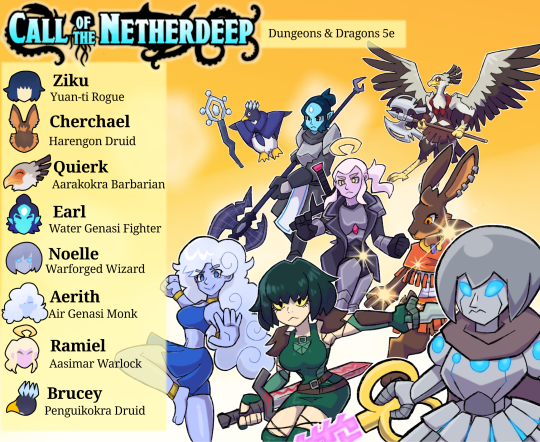
My main contribution to D&D for the year was as Dungeon Master for a prewritten campaign called Call of the Netherdeep. This is an adventure set in the world of Exandria, the setting for Critical Role, which I made sure was not required reading for my players. Player buy-in became more about integrating the stories of individual characters as part of the adventure.
Since this year of TTRPGs was just as about my players as for me as a DM, I decided I would highlight their characters as a main part of this art.
Since I ran Netherdeep as a milestone campaign, it was up to me to decide when my players had achieved enough to level up. In my opinion, the middle part of the adventure, that aims to cover levels 5-9, is nowhere near enough content to justify that much experience. So I used aspects of several characters' backstories to invent longer side-quests. Of the 17 sessions I ran this year, 8 sessions explored adventures not in the book. Refer to sessions 10A-14A for one side adventure, and sessions 12B, 13B and 15 for the other.
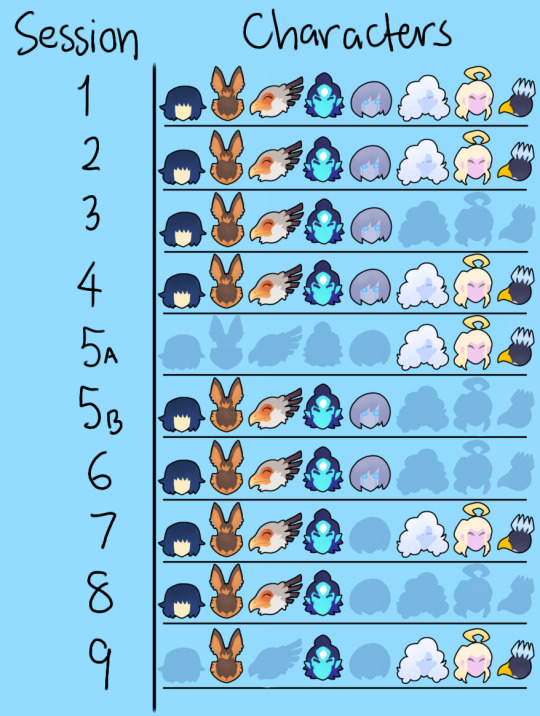
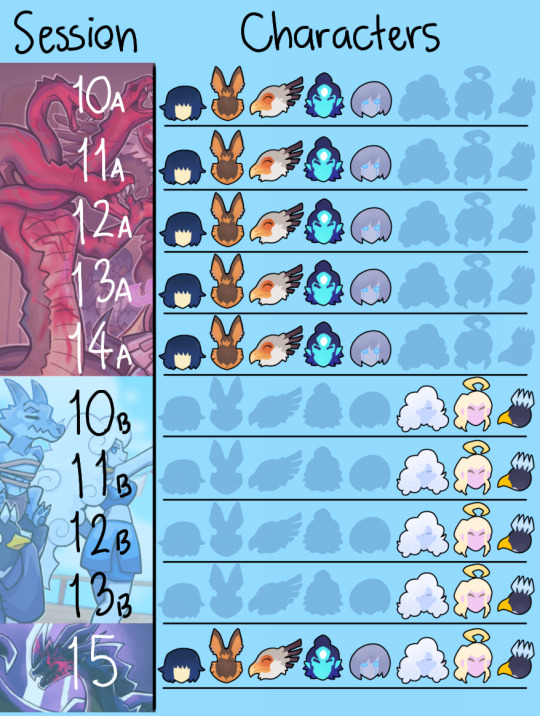
Since I was running for 8 players, 5 in one party, and 3 in a rival party, I decided that once the party reached the main hub town, I could just run for whoever was free that week. This changed when I started running those aforementioned original adventures, but since those two stories ran in parallel, it became, "If I have all the players of Party A free, I'll run a session in their POV, if I only have players from Party B free, I'll run a session in their POV". The number of sessions I ended up running would not have been possible without this flexibility.
Pokémon Oster

Pokémon Oster is based in the fictional continent of Oster, the Pokémon equivalent to Australia. Our party of trainers has been exploring the west and central parts of the continent to uncover the mysteries of corrupted Pokémon called "Typos", and thwart the plans of evil(?) organisations Tech Industries and The Galactic Corporation. Last we saw our party, they met with a group of researchers searching for Oster's obscure Legendaries in hopes to stop a bigger force.
In this campaign I play as Darryl Fisher, a bogan from the south-east of Oster who has a drive for mystery and adventure. Darryl is a man of the sea; a fisherman, and a diver, who only trains Water type Pokemon. His partner Prinplup has helped the group out of a few scrapes, and his recently evolved Gyarados is sure to help them overcome many odds.
I play Darryl as blunt and a little stupid, but he is curious, and has a taste for the supernatural that I use to prompt my natural note-taking playstyle. I have the final roster of Pokemon he wants to train in his team already (once they all evolve of course). But if one of those mysterious Oster legendaries is a Water type, maybe he'd be intrigued.
The Southern Blood Rush
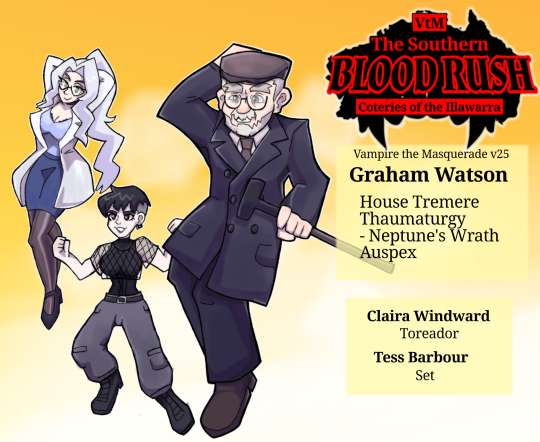
Vampire the Masquerade is a system that takes place in a world adjacent to the real world, but vampires and other supernatural creatures are real, and hide in the shadows, pulling the strings and having hidden wars of politics and espionage. The Southern Blood Rush is a story based in the World of Darkness's equivalent to the south coast in NSW Australia. The GM is actually running two campaigns that will run in parallel, with my group's campaign set in the city of Wollongong. Maybe further into the campaign we will have a crossover?
Graham Watson is my Vampire character. An Englishman by birth, Graham lived most of his long fulfilling life in Australia, before being turned into a Vampire at the age of 77. Graham's natural inclination to both the sciences and the occult attracted the attention of House Tremere, a clan of vampire mages. Since turning, Graham has gained the ability to control water, a discipline called Neptune's Wrath, and has used it to convince other vampires in Wollongong to make alliances.
I play Graham as careful, studious, and paranoid. He was about to ready to die, but now that he has eternity ahead of him, he is afraid of death more than ever. Graham tries to take a back seat in his coterie, but knows that the smaller presence of Tremere in his city means that he must sometimes show his hand to get what he wants.
One-Shot Adventures
The Lich Who Stole Christmas

October-November last year, I had my players for Netherdeep make spare characters for a One-Shot I ran called Frozen Memories. When it came to actually running the adventure, only 4 of my 8 players were free. But I had another adventure I wanted to run later, so on New Years Eve 2023, I ran another one-shot called The Lich Who Stole Christmas for all 8 players.
This was a fairly short and lighthearted adventure, and there's not much more to add. There were a couple riddles and puzzles that engaged the whole table. Combat wasn't difficult overall, even if the final boss gave them a bit of a scare. But the point wasn't to be challenging, it was to be fun, and I think this One-shot achieved that.
Phandalin After Dark

Toward the end of 2024, a couple of new D&D core books came out introducing updates to the current edition of D&D, unofficially known as 5.24 Edition. Since one of my Netherdeep players, Aerith the monk, had been using playtest versions of the new character options already, I decided we could use a one-shot to try out the new rules, and see if I want to implement them in the core campaign.
Phandalin After Dark was a prewritten adventure about a group of characters visiting a portion of the Shadowfell. I had all 8 players make up a character, but again, only 4 could play on the day. The adventure was good at building atmosphere, and the combat encounters were often very intimidating. But many puzzles often led to no tangible reward, just letting the characters live. It was an overall positive experience, and served its playtesting purpose, but I think the next one-shot I'll run will be more of a traditional dungeon crawler.
Next Year…
As of a couple months ago, I had decided to put Call of the Netherdeep on hiatus. The DM for Princes of the Apocalypse has expressed interest in starting up again in January, and the GM for Vampire wants to get in a few months on that campaign before getting back to Pokemon eventually.
After a good break, I will pick up Netherdeep again and hopefully finish that campaign next year. After that, who knows.
#digital art#art#drawing#d&d#d&d art#d&d campaign#dungeons and dragons#d&d oc#dungeons and doodles#master post#masterpost#character design#original characters#season finale#seasonfinale#call of the netherdeep#pokemon#pokemon tabletop united#vampire the masquerade
6 notes
·
View notes
Text
The Dionysos gallery (4)
We finally reach the end of this long Dionysos series - and after dissecting the myth of Dionysos, we reach the conclusion of this gallery, kindly offered by the French Museum of Wine (you can find it all here).
First, I will include there the various paintings I did not have enough space to add in previous post, two paintings coupled with an analysis section I will loosely translate.
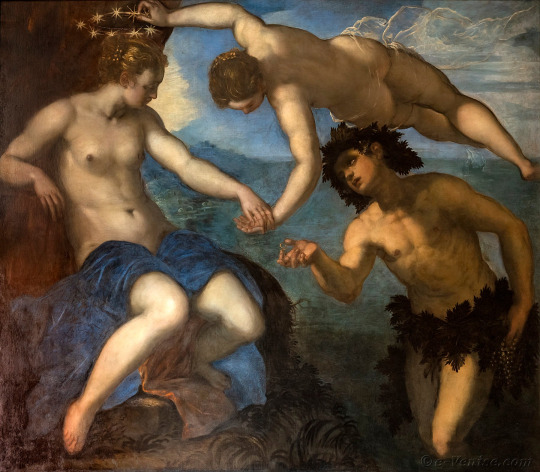
Le Tintoret's Ariadne, Venus and Bacchus
The motif of the encounter between Bacchus and Ariadne (who had been abandonned by Theseus on the island of Naxos) and Bacchus' offer to the woman of her famous gold crown made by Vulcan (according to Ovid's Fasts), has been a strong recurring motif in paintings, explored by numerous artists.
"Liber" or "Liber Pater" was originally a fertility/fecundity god whose worship took place within the oldest era of Ancient Rome. By the 7th century BCE onward Liber was associated with wine, and as a result the Romans ended up assimilating him with Bacchus/Dionysos. "Liber" as such became a mere Latin translation of the terms "Dionysos" or "Bacchus" - "Pater" meanwhile kept its role of expressing respect and adoration towards a god.

Jan van Bijlert's The Feast of the Gods
This 1630 painting currently kept at the Magnin Museum (Dijon) asks a quite troubling question: is this pagan scene... secretly a Christian Last Supper?
We are on Olympus. The gods are gathered for a feast. On the left we see Minerva, Diana, Mars and Venus, with Cupid by their side and Flora behind them. At the center of the table, a crowned Apollo appears holding his lyre. To the right we can recognize Hercules thanks to his mace, and Neptune with his trident. Unfortunately several of the Olympians are missing due to the painting having been cut off: for example there is a peacock, but no side of Juno. The motif of the "feast of the gods" was very popular in Holland, ever since an engraving by Goltzius "The Wedding of Psyche and Love" (see below).
However, van Bijlert's painting can be read very differently. In the Netherlands, due to the appearance and domination of Protestantism, all pictures had been banished from the temples, putting an end to the religious painting. As such, it seems that this painting hides within it a Christian scene of the Last Supper. Apollo at the center has the same halo as the Christ usualy has, and the characters surrounding him are twelve in total like the Apostles. Now, while it is a very interesting theory, we should stay careful. As we said before, it seems the reason some of the gods are missing is because the painting was cut (a practice very common at the time) - again, there's this peacock that implies Juno used to be included. Second element: yes the Christ has a golden halo in painting to symbolize his role as the Lord of the Heavens, but long before that, the idea of a halo of light did belong to Apollo. The Greeks saw him as the "solar god" by excellence, since he was the power that ruled and organized all things, and the one that regulated spirits and intelligences (in fact, he was complementary of Dionysos since Apollo tamed, controlled and shaped the vital force and bursts of life embodied by Dionysos).
Bijlert lived in Rome in the beginning of the 1620s and we know that, just like many of his fellow painters, he was deeply impressed by the art of Caravaggio. However, the Italian painter's fame was dwindling by then - and by the 1630s his art had lost any influence over European paintings. In this decade, Bijlert focused his works on the new international trend, the classicism. Here the composition of the panting and the diurnal luminosity are purely classicist. However, the dancing satyr and the leaning Bacchus on the foreground belong to the "naturalism" of Caravaggio: ocre-colored flesh, close-ups on bodies in non-conventional positions...
(Here is Goltzius' engraving)

Second part of this post, extending from the analysis above: Christianized Dionysos! Because yes, you might be surprised to learn that the motif of Dionysos/Bacchus in classical painting was heavily Christianized or syncretized with Christian figures...

Leonardo da Vinci's Saint John the Baptist
This Saint John the Baptiste has what has been called a "pagan beauty", and this painting with a Tuscany imagery "renews the syncretism of the patron of Florence" - perhaps due to the passion for Antiquity the town had when the painting was created. Indeed, while saint John here holds a cross symbolizing the Passion of the Christ, he is dressed in a panther's skin, reminding of the cloak of Bacchus...

Leonardo da Vinci's atelier: Saint John the Baptist-Bacchus
Once again this painting shows the syncretism between the figure of saint John and the character of Dionysos. The painting was first recorded, in the royal archives, as "Saint John in the desert". However, at the end of the 17th century, perhaps due to a restoration of the painting, the name was changed to "Bacchus in a landscape". Here we have Christian symbols: a finger raised to the sky, a stag resting on the ground... But we also have Bacchic attribute: a thyrsus, grapes, a panther's skin, and a crown of what might be ivy or vine-leaves.

Caravaggio's Saint John the Baptist
Here again we have the attributes of Bacchus: the vine, of which Bacchus was the god, and a ram, an animal traditionally sacrificed for the deity. Historians of painting are agreeing that the reason the Caravaggio associated John the Baptiste with Bacchus was because it allowed him to depict the saint naked, and eroticized, very probably to reflect his own homosexuality.
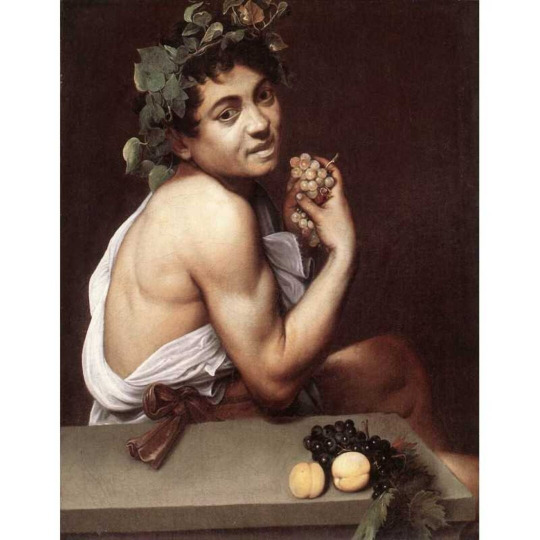
Caravaggio's "Sick young Bacchus/ The ill little Bachus"
This panting of Caravaggio has been interpreted as a self-portrait in a Bacchus-Christ fusion that is very sexual. Here, Caravaggio offers himself to the libertine cardinals of Rome, in an erotic "communion" (remember, "eucharis", means "the good flesh"). The action of carrying to his lips golden grapes gorged with juice is very sensual. Crowned with ivy, dressed in an ancient toga (which reveals a muscular shoulder), he is holding green grapes to his chest, as if he was about to press them. It has been thought that there the Greek wine of Dionysos is a mask or assimilation for the wine of the Christian mass - the invitation is for always a greater feast and bigger celebration, the wine of the Christ "subliming" the wine of Bacchus, ultimately becoming the wine an "universal mass" beyond any religion or era.
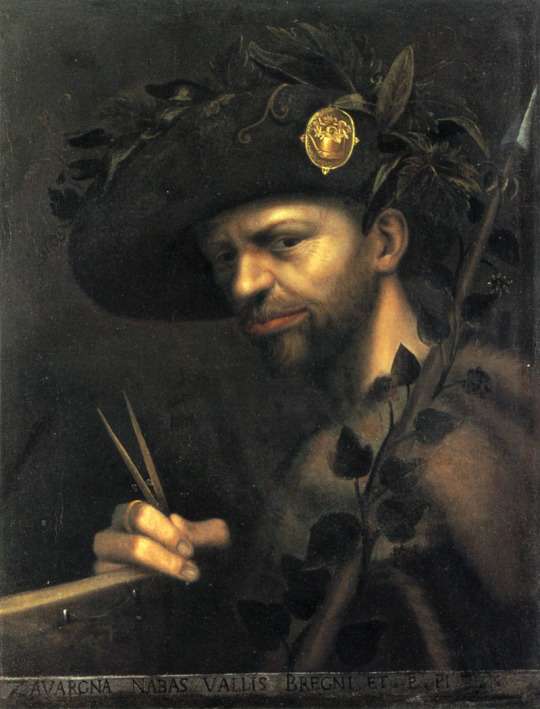
Giovanni Paolo Lomazzo's "Self portrait as a crowned Bacchus"
This painting depicts Giovanni Paolo Lomazzo in his outfit of president (called an "abbot") of the Acacademia della Val di Blenio (Ticino) - Lomazzo had just been named to this function, as the inscription at the bottom of the picture reminds the viewer. The Academy gathered all the best artists of Milan - painters, sculptors, musicians... And it was placed under the protection and patronage of Bacchus, the god that relieves from sorrows and worries, the god that inspires joy, the god that stimulates the mind and the creation, the god that frees from bondage. As such, it explains why this self-portrait has Lomazzo as Bacchus. It was an answer to the many disasters of the era, as well as to the new austerity imposed by the figures of the Counter-Reform - such as Charles Borromée, who was the archbishop of Milan and a cardinal within the Catholic church.
The Bacchic references are numerous here. The hat is wrapped in a garland of laurel and vine, with a medallion depicting vine too. There is a thyrsus surrounded in ivy. And finally there is a goat-skin, reminding of how when he was a child Bacchus was turned into a "kid" (baby goat) to avoid Juno's wrath. The compass however within the man's hand is not a symbol of Bacchus. Held like a paint-brush, it is meant to symbolize how Lomazzo "leads" and "drives" his own career like a captain would pilot his ship.
#the dionysos gallery#the art of the myth#dionysos#dionysus#bacchus#syncretism#saint john#john the baptist#art#painting#folk christianity#christian art
19 notes
·
View notes
Text
Canon Queer Characters in Doctor Who

why yes, keeping a spreadsheet documenting the queer representation in doctor who is a completely normal thing to do during a rewatch why do you ask
Season 1 & 2
Putting these together because they're off to a similarly disappointing start. The Doctor isn't even confirmed genderqueer yet. Weak. Shout-out to Jack for carrying season 1 on his shoulders all on his own.
(details on my criteria for queer representation below the cut)
The rules for getting onto this spreadsheet are very loose. One-off mentions count. So do jokes. So do off-screen characters. Oh, a writer implied you snogged a woman for a joke? Congrats, you're going on the spreadsheet.
Canon representation but no specific labels means they get listed by vibes (e.g. bi vs. pan). Feel free to fight me on my choices! I'm very willing to make adjustments.
To differentiate between tiers of representation I included the "Role" and "Canon" columns: in order of importance from low to high it goes off-screen, side character, supporting character (played a major role in their episode(s)), recurring (played major roles in several episodes, perhaps across seasons) and main (Doctor or companions). For canon, we have implied (which could mean it was vague, up to interpretation or possibly meant as a joke), stated (clearly said within the story at least once), or explicit (on-screen kisses, regeneration to a different gender, sexuality/gender as an integral part of the character/the story or something that keeps being brought up, etc). I'm also including characters using lgbtq+ inclusive language as "allies".
To make it a bit more organized, I used purple to signify tier-level. Dark purple for the Doctor and queer companions, medium shade for recurring characters like Jack, light purple for supporting characters who feature majorly in their own episodes, white for side/off-screen characters or allies.
Only the main show counts! If a character is confirmed queer in an audio drama/a spin-off, but there's no mention of their orientation/identity in the main show, you won't find them on the spreadsheet.
Let me know if you can think of characters I've forgotten!
20 notes
·
View notes
Text
(Further) Beyond Dream Daddy: A Year of More Gay Dating Sims
Last year for Pride I made a video sharing my thoughts on a selection of gay dating sims, among them Dream Daddy - by far the most well-known title in that genre. My opinion of that game was rather unfavorable, to say the least, but nonetheless I had a lot of fun discussing the topic. Dating sims rarely get any significant analysis or consideration, so it was a novel experience on that basis alone.
Recently, a patron of mine expressed a desire to see me talk about dating sims again. To save myself some work on a project when I've already got so many others going on at the moment, I've opted to do so here on my blog rather than on my channel this time. This also has the added benefit of giving me more latitude to discuss the NSFW qualities of these games without needing to censor myself. When the majority of the titles in this space are explicitly erotic, that's kind of a big deal.
Anyway! Here's a selection of games that I've played in the past year that I thought were worth looking at in some more detail.
Dear Monster
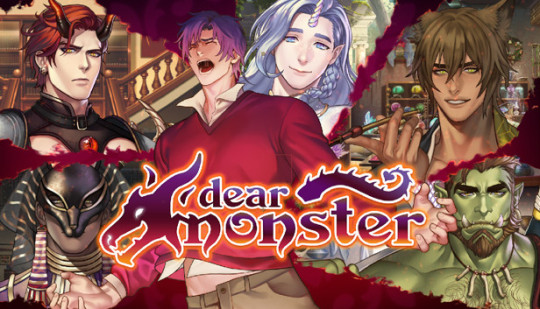
As the title suggests, this one is for the monsterfuckers out there.
This is, sort of, the second time I'm discussing a project by Y Press Games. I've touched on an earlier game of theirs, To Trust an Incubus...but I found it so unimpressive that I never bothered to review it in-depth. In several ways you can tell that Dear Monster comes from the same creative team: there's a similarly large focus on plot with a bunch of variable endings including some very dark ones, all the characters are vers despite many of them playing into familiar top or bottom archetypes, and most obviously the main theme is monsterfucking.
In this case the selection is much broader, as instead of a single species of pheromone-emitting aliens you get your pick from a variety of fantasy creatures. I say "creatures" because Dear Monster isn't afraid to shy away from furry/scalie erotic content for certain scenes, although most of the time the love interests stick to their humanoid forms. There's
a Western dragon as the violent bad boy love interest;
an Egyptian-flavored god of the dead, whose alternate form resembles Anubis and who plays the standoffish tsundere role;
a kitsune for the mischievous and overtly sexual option;
a unicorn who comes off as the caring submissive choice...mostly;
and an orc, who's had a route announced as free DLC later this year but who currently exists only as a recurring NPC
As I said, like To Trust an Incubus there's a noticeable focus on plot here, with the protagonist being a young man newly introduced to the world of the supernatural and trying to locate his mysteriously vanished grandfather inside an obviously magical mansion. Also like their earlier game, there are some unexpected plot twists that I won't spoil here, and overall I'd say this game pulls them off more effectively even if the ending feels a bit unfinished currently. Maybe they're waiting for the orc character's route to properly tie off the story? In any case, Dear Monster is better written than its predecessor and comes with an appreciable variety of kinky scenarios, and despite the lack of voice acting (a very hit-or-miss topic when it comes to dating sims, as I've discussed) the production values are overall quite good. The animated character portraits have been advertised as a highlight but frankly don't contribute to much, and they have a tendency to slow down my computer. Luckily though, they're easily turned off.
Favorite route: A hard call. They all have their highlights, and I'll probably enjoy Slagathor (the orc) when his route comes out. Hikmat (the god of the dead) probably comes out a bit ahead of the others both for his story and for some unexpectedly adventurous sex scenes, like one that incorporates a variant of tentacle porn - points for creativity there. Faeryn (the unicorn) is the one I find least appealing sexually, but on the flip side his route has some of the most unexpected twists and is probably the most helpful for understanding the game's premise as a whole. There's not really a bad option here.
UPDATE: Now that the final route has been released, I can talk about it. It's fine enough, following similar tracks for its good, neutral, and bad endings. Slagathor is vers, just like every other guy in the game. As for the main plot, it does have a resolution once you've gotten satisfactory endings with all five characters, but because it has to be integrated into all of those route endings and doesn't actually impact any of them it feels rather inconsequential as a result. A bit of a shame, really, but I do respect the boldness of some of this game's narrative chioces.
Camp Buddy
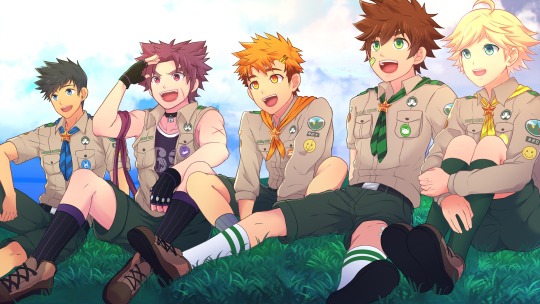
Oh, dear. There are some things I need to make clear with this one from the start...stuff I definitely couldn't talk about on YouTube.
To state the obvious first: yes, the characters are all 18+. It's in their in-game profiles, on promotional material online, and on the disclaimer you have to click on whenever you boot up the game. The main character and all his love interests are specifically stated to be 18-20 years old. However...that doesn't always bear out in the writing. The premise is that they're all campers at a scout-themed summer camp, i.e. not something you'd expect of legal adults, and more than half the time these characters are written with the emotional maturity of boys in their mid-teens. That doesn't extend to the sex scenes, beyond most of them being virginal and clueless but somehow still capable of having mind-blowing sex with no lube and simultaneous orgasms and so forth - all of which is pretty standard for these sorts of games. It doesn't consistently affect their storylines either, as they range from adolescent issues like anxiety over losing a close friend to more young adult material like deciding on career paths and moving on from a bad breakup. Having spent a good bit of my own adolescence in an all-male environment, I found most of the character behavior relatable for that demographic. Outside the sex scenes, Camp Buddy is a sweet and sometimes heartwarming story about friendship and making good memories...but the sex stuff is still there, and I can understand why this game isn't listed on Steam based on the premise alone. It is not, as some online have hyperbolically dubbed it, a "child porn" game, but it can be awkward all the same, and if you, like me, are not into twinks/twunks those scenes aren't going to do much for you.
Leaving that aside, it still took me a while to get into Camp Buddy. I was mostly interested in its sequel, which I'll talk about later in this post, but I wanted to play CB in case I missed out on any context with the second game. This one does feel like a first project; the artwork isn't as clean or varied, the voice acting has some standouts but is overall just average, and the script occasionally reads like it was written by someone whose first language isn't English - where the writing isn't incorrect, exactly, but rather worded in ways that don't sound natural. Not all of the scenes are fully voiced, but I really have to wonder how some of those that are got through all those people without anyone realizing how inorganic the dialogue sounded. The humor at least is pretty consistently good, with a highlight being the one major female character who is an affectionate parody of yaoi fangirls leading to a lot of fourth-wall-breaking jokes. As I said some of the storylines work well, even if the main plot is a clichéd and sometimes treacly "save the camp" routine for most of its run. If you can accept the handwave on the characters' ages for the sexual content, it's not a bad time. Given my familiarity with Fire Emblem and its love of underaged-looking dragon girls, and knowing that there are surely far more dating/porn games that use a similar handwave for female characters, I can give CB a pass. I've never cared for how media directed at straight men never warrants more than a moment's worth of moral outrage while everything else gets endlessly scrutinized.
Favorite route: Yoichi is the twunk-iest of the love interests, and his route is easily the darkest as well. Surprisingly he's not the sole total top option...but the guy who is barely grasps of the concept of masturbation and needs to "research" sex after he fools around for the first time. I suppose someone must be into that. Taiga has the most distinctive route as it was added last and has the largest amount of story variance as well as both topping and bottoming variations, but I find the emotional beats of his story (both in and out of his route) to be paced a bit too oddly for me to give him first prize.
Camp Buddy: Scoutmaster Season
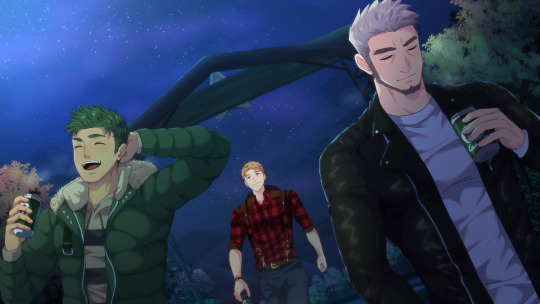
This is why I played Camp Buddy, because I saw its follow-up advertised on Steam and was impressed enough by the production values to check it out. I still bought it from developer BLits's website though because certain scenes are removed in the Steam version (for reasons similar to why Camp Buddy isn't there at all). Anyway, Scoutmaster Season is in just about every way a vast improvement over its predecessor:
Most obviously, the characters here look and act unambiguously like adults. Their storylines are also more mature, as is that of the main plot which concerns the camp expanding after it received a new wealthy investor at the end of CB. This maturity extends to the sex as well. These characters aren't experimenting adolescents but rather men who've been casually involved with one another for some time already (heavily implied in the first game) and whose romantic development thus concerns their relationships becoming grounded in emotional support instead of only hot NSA sex.
Camp Buddy is a decently kinky game in its own right, but the sequel takes advantage of its older characters and really runs with the concept. There's bondage, leather, voyeurism, softcore daddy kink, public sex, several varieties of costume role play including two that verge on pony play, threesomes, and a few types of size kink thanks in *ahem* large part to one of the love interests having such a comically oversized cock that in some encounters it can be seen distending the main character's stomach during penetration. I'm...pretty sure that's not physically possible, but I know it's a fantasy that exists. SS is just as unrealistic when it comes to things like (lack of) lube and refractory periods, but that's to be expected at this point.
I didn't talk about CB's minigames because they're frankly not that impressive, but SS's are both a bit more challenging and, in the case of the foreplay minigame, hotter and more interactive.
The writing is much improved, and flows more naturally. The voicework is overall of a higher quality as well, even with many in the cast reprising their roles. Particularly, the same voice actor plays the main characters of both games, but he sounds much more natural as the deeper-voiced lead here, in contrast to CB where he has to work to sound like a teen. The comic relief is about on par, so it's as entertaining as usual. There's even a yaoi fanboy in this one...who funnily enough never actually gets laid during the story, although the artists threw him a bone or six with a bukkake party crack scene in the extras.
SS's antagonist is both more compelling and more entertaining even though she never becomes a romance option - as should be evident from the pronoun alone. I predicted where the story was going to take her arc the first time I played, and while I was proven right the game didn't follow that thread to its logical conclusion. A bit disappointing, but I imagine that that would have obliterated the tone for the rest of the game and prevented it from ending with fluffy romance or celebratory sex.
There are enough small callbacks to CB that I'm glad I played the first game, but not so many that a newcomer would feel completely lost. As this is the only gay dating sim sequel that I can even think of, I appreciate the attention to continuity.
BLits is currently working on a third game called Jock Studio, unrelated to Camp Buddy but already looking to be an evolution of what they've learned from their first two games. The athletic university premise appears to be a self-indulgent excuse for porn - but I'm more than okay with that seeing how much the quality of their work has improved.
Favorite route: There's only two here, so naming one would be suggesting I dislike the other. In fact, both routes are really solid. I would say that Aiden's story hangs together a little better and feels stronger in its emotional moments (helped greatly by the best vocal performance in either of these games), whereas Goro's route appeals to me more based on raw sex appeal. He's a kinky daddy, what's not to love? Either way, SS is a ton of fun, and of the games in this post it's the one I recommend the most strongly.
Errant Kingdom
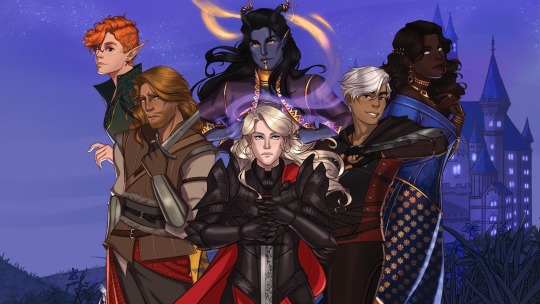
I'm of two minds about including this game. I really wanted to have one that would be drastically different from the others I've selected, but at time of writing I haven't done everything there is to do in Errant Kingdom. That's not for lack of time, as it's been released in chapter increments ever since last autumn or thereabouts and finally finished up in February. I've currently completed two of its stories so I feel like I have a solid grasp of what's on offer, but I realize that I haven't seen everything yet.
However, I had to keep pushing myself to play this one. It just doesn't have a very strong hook, in my opinion, but let's talk about the positives. If your main complaint about Dream Daddy is not the lack of hardcore gay sex but rather the inauthenticity of its representation then Errant Kingdom will be more your speed. Your character can be male, female, or nonbinary, and there are two love interests of each designation available. (That both nonbinary options are supernatural non-humans might arguably be a bit of a copout...but I'm not really in a position to judge.) There are also two options for poly relationships, as well as asexual dialogue options although the way the story is set up does still lend itself toward monogamous romance with occasional, vaguely-described (and never visualized) sex scenes. I'd also note that unlike every other visual novel with romantic elements I've ever played, dialogue options are explicitly marked as being romantic, asexual, or poly when applicable. This does make it much easier to get a specific outcome if you're looking for one, but in my view takes away some of the fun of these sorts of games.
Errant Kingdom's story is quite linear regardless of which if any romantic relationship(s) you choose to pursue, with the largest variance coming not from your choice of love interest but from your choice of one of three origins when you're creating your character: an ambassador, a knight, or a nomad. Having played through two of these, this decision greatly impacts the game's opening chapters but ultimately leads into the player characters being three different points of view on the same story, with all the same major set pieces. Errant Kingdom is occasionally clever about this, with the other two PCs popping up in each other's paths every now and then...unseen of course, because this is a game where the main character's physical presence is left entirely up to the imagination. On the other hand though, the different perspectives converging toward a single climax has the clunky side effect of dropping certain NPCs into the story lategame and acting as if you know who they are even if you've never met them in that playthrough.
The story itself isn't terribly fascinating, being a medieval fantasy conspiracy plot involving gods and magical weapons and an 11th hour Chosen One reveal (that isn't the player character, shockingly). If we're talking pseudo-medieval/early modern romantic visual novels, I find I prefer the Chess of Blades approach where each love interest gets his own storyline and so there's more overall variety and less tangled continuity. I've read in places that the later chapters suffered from deadline and creator burnout issues during development, which wouldn't surprise me with how much the pacing speeds up after a certain point.
Favorite route: For origins the ambassador angle suited me better and would probably be my pick overall. The choice of love interest is, as mentioned, actually not all that important, but disgraced former knight Erik hits most of my buttons. It's a shame his poly option is with a woman, because while Maja is my preference of the two female options I wouldn't be invested in her like that. This is the trouble for me with stepping outside the bounds of strictly M/M games.
30 notes
·
View notes
Text

This issue, Kitching & Elson bring us “Pirates of the Mystic Cave” and- …Amy’s been kidnapped again already? Gosh darnit, that’s not off to a good start for her!
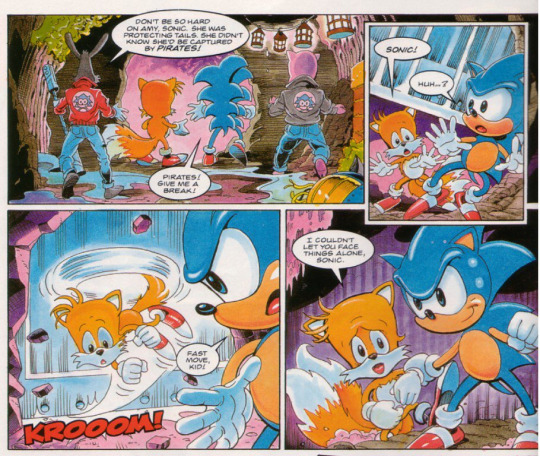
Okay, at least she went out protecting Tails. According to Johnny, who may or may not have had a crush on Amy and wanted to defend her honour. I really don’t know
Also, we get a rare bonding moment between StC Sonic and Tails to enjoy! See? It wasn’t all bad between them. Tails is the only one who got through the door, so Porker and Johnny will be twiddling their thumbs (or hooves, in Porker’s case) until they get back

The two encounter some badniks, which knock them both out. I like the detail of Tails’s tails spiking as he gets gets shocked
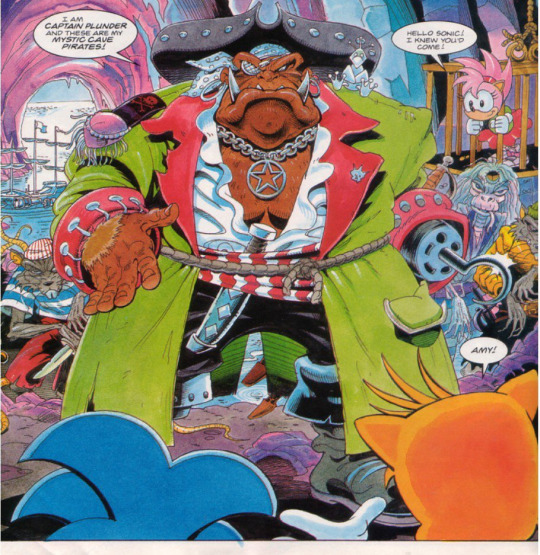
Here he is, Captain Plunder! Along with some of his crew, which doesn’t presently include one of its better known members, Simpson the Cat. Regardless, Plunder is here to boost the non-Robotnik villain roster and, also, Amy doesn’t seem remotely worried, so good for her
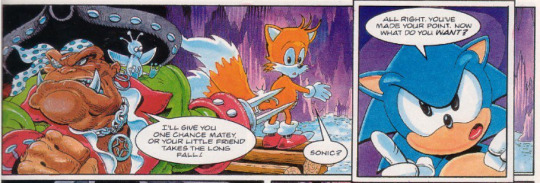
This is a good issue for the “No, StC Sonic really does care about Tails, he’s just very British about it” argument

What Plunder actually wants is the Chaos Emeralds, which Sonic refuses to give him on the grounds that he doesn’t want Robotnik to have them. I guess that casually confirms that Sonic does have all the emeralds right now, which would make sense, given that the comic is set after Sonic 2 and we’ve seen him go Super Sonic a couple of times. Yes, they didn’t imply his super transformation was because of the Chaos Emeralds during either of those times, but that’s how I’m reasoning it in my mind
Anyway, this is when Plunder confirms that he’s not working for Robotnik, he merely stole the badniks and now they listen to him

I feel like most of you have probably seen “Tails! You can fly you idiot!” before, but now you’ve got the context for it
We also get a proper introduction to one of Plunder’s crew, Filch, who Plunder killed himself. I love how casual Filch is about this. Like, he becomes a ghost and is like “Oh well, I shouldn’t have taken that extra biscuit” and then continues to serve Plunder. You have to admire that
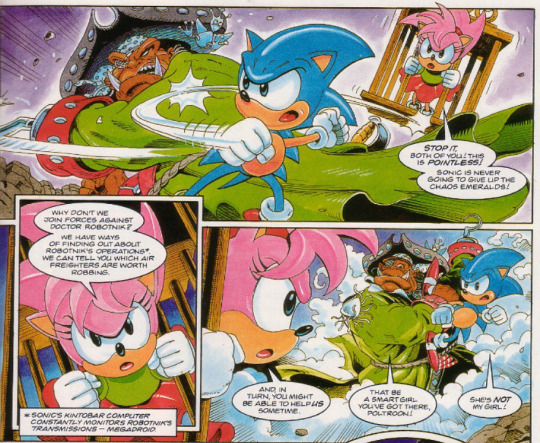
Amy is the one who ends the conflict by using the age old logic of “The enemy of my enemy is my friend”. I know some could argue that this is a typical “girl character stops the boys from fighting” angle to throw at her, but I’m just glad to see Amy getting to solve a conflict after being kidnapped for her first two appearances
And it looks like “villains confusing Amy for Sonic's girlfriend” is just the running gag of the time

To no one’s surprise, it seems that Plunder doesn’t intend to make good on his side of the agreement, since he wants the Chaos Emeralds more than anything that raiding Robotnik’s air freighter could get him. I guess part of that plan could be letting the trio go today and maybe we’ll find out next time, since the teaser says the story is called “Slave Ship”. Or maybe it’ll be further down the line? I actually don’t know. Especially since Metal Sonic’s appearance is also on the cards
Like I’ve said before, I like Captain Plunder. There’s no deep reason behind that, I just think pirates characters are fun and I’m glad to see more villains outside of Robotnik. We have had several other villains before now, even some who’ll be recurring, but so far they’ve all worked alongside Robotnik to some degree. Plunder and his crew are the first ones who are doing their own thing and I feel the comic is ready for it by this point
#sam observes sonic#sonic the comic#stc issue 23#sonic the hedgehog#amy rose#miles tails prower#johnny lightfoot#porker lewis#captain plunder#filch
12 notes
·
View notes
Text
Dawg I am BEYOND tired of seeing people romanticizing Bpd and people with Bpd. It is genuinely disturbing to me how normalized it is too. A quick scroll on TikTok and you will find people being like “When she’s literally obsessed with me 💕” or “POV: I have a girl with Bpd so she’s utterly in love with me and never leaves” or some other TikTok slideshow bullshit.
(I have made this partly factual, but a lot of it is very personal. please read at your own leisure.)
To me, it is utterly dehumanizing. As someone with Bpd, I wouldn't wish this on ANYONE. I struggle almost every damn day to control and regulate my emotions so I don't blow up at someone or breakdown over something I MADE UP to sabotage myself. I am not some fucking character who will do anything to have you or will kill just to be with you. I am a REAL PERSON with a VERY REAL AND MENATLY CRUSHING MENTAL ILLNESS. I am not some one-sided person with only one goal. I am just like literally everyone else on this goddamn planet!!!!! I just act and think differently!!!!!!! And honestly, do any of you people realize what you are asking? Do you REALLY know what you are getting into? Because it’s uneducated people like that who romanticize Bpd to the point where others think it’s “only obsession”.
And boy do I have a HORRIBLE surprise for you. Lets have a little psychology lesson, shall we?
According to NIMH (National Institute of Mental Health)*, "Borderline personality disorder is a mental illness that severely impacts a person’s ability to manage their emotions. This loss of emotional control can increase impulsivity, affect how a person feels about themselves, and negatively impact their relationships with others." (This is sectioned under "What is Borderline Personality Disorder?")
"People with borderline personality disorder may experience intense mood swings and feel uncertainty about how they see themselves. Their feelings for others can change quickly, and swing from extreme closeness to extreme dislike. These changing feelings can lead to unstable relationships and emotional pain.
People with borderline personality disorder also tend to view things in extremes, such as all good or all bad. Their interests and values can change quickly, and they may act impulsively or recklessly.
Other signs or symptoms may include:
Efforts to avoid real or perceived abandonment, such as plunging headfirst into relationships—or ending them just as quickly.
A pattern of intense and unstable relationships with family, friends, and loved ones.
A distorted and unstable self-image or sense of self.
Impulsive and often dangerous behaviors, such as spending sprees, unsafe sex, substance misuse, reckless driving, and binge eating. However, if these behaviors happen mostly during times of elevated mood or energy, they may be symptoms of a mood disorder and not borderline personality disorder.
Self-harming behavior, such as cutting.
Recurring thoughts of suicidal behaviors or threats.
Intense and highly variable moods, with episodes lasting from a few hours to a few days.
Chronic feelings of emptiness. Inappropriate, intense anger or problems controlling anger. Feelings of dissociation, such as feeling cut off from oneself, observing oneself from outside one’s body, or feelings of unreality."(This is sectioned under "What are the signs and symptoms of borderline personality disorder?")
I am no expert and I do not claim to be, but I know for a FACT that most if not majority of people who romanticize Bpd don't know ANYTHING about what actually goes on in someone with Bpd's head. From my experience, it is never quiet. In the back of my mind I have a small but convincing "voice" that tries it's hardest to make me crack. And by crack, I mean believe it's false and twisted words. For a hypothetical example, Say one of your friends goes a while without texting you. a rational mind would say "they're probably busy, or not going on their phone at the moment". Someone with Bpd would probably think this too at first, but their very unhelpful little voice in the back of their head would chime in. "But what if they're doing this on purpose? What is they think you're annoying? You are annoying. That's why they won't talk to you. You're being too much of an inconvenience so they've found other people to talk to." People with Bpd tend to become more irrational due to a false sense of distrust via these thoughts. it can be extremely devastating to one's mental health and make them feel insecure. it's not all sunshine and rainbows.
BUT!!!!!!! While this mental illness is absolutely terrible to deal with, there are ways to treat and cope with it. While it seems like hopeless and never-ending, there's always a way to make the best of it. You just have to discover what works best for you. ^^
In conclusion; Bpd is no joke, and it shouldn't be taken as such. I would go into more depth, but it is very late while I'm typing this and I need some sleep. Please do your research before making this heinous shit online, if anything it just shows idiocy, immaturity, and lack of understanding. Of course I know I cannot change other's opinions and there will always be people like this, but I can only hope this post sheds at least a little light on this topic. If you've made it this far, thank you for taking time to read this, and have a wonderful rest of your day/night.
*source: https://www.nimh.nih.gov/health/topics/borderline-personality-disorder#:~:text=Borderline%20personality%20disorder%20is%20a,impact%20their%20relationships%20with%20others.
#bpd#borderline personality disorder#rant#mentalheathawareness#mental heath issues#mental health#actually bpd
9 notes
·
View notes
Text


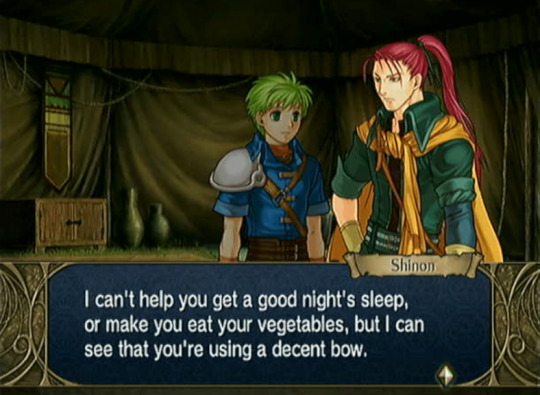
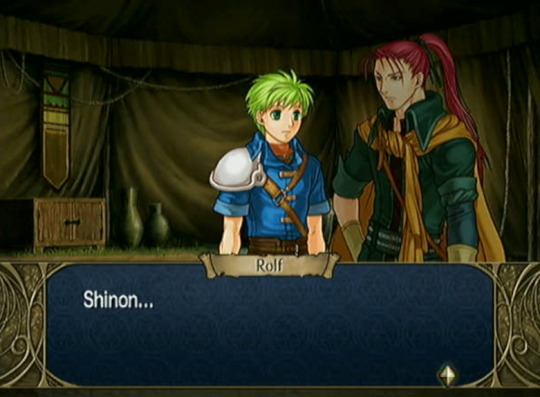










I know you all know by default how much I love this conversation, but in RD at least, a lot of characters fall out of relevancy after a certain point (whereas in PoR you could argue that having full supports prevents this). Shinon is one of the only side characters who doesn't really do this, having three base conversations throughout part three (which is pretty fucking good considering several of the chapters aren't even with the Greil Mercenaries).
Back in PoR, Shinon asks for praise/gratitude. Expects it. By this point he doesn't want it anymore. He didn't want it when he was selling bows for emergency income (which Rolf took up as well) and he doesn't want it here either. His personality has chilled out so much from being a hothead and he's much more expressive of his actual feelings (even if you compare his standard death quotes in both games, he's much more emotionally expressive in RD).
A lot of characters - most honestly, including even the GMs (barring Boyd if he A supports Mist which gives him more content and expresses a whole lot of maturity compared to PoR Boyd) tend to drop off in development. They might stick around (ex. PoR puts all the major groups in the spotlight until the next group shows up and goes through all of them), but the development eventually stagnates outside of supports (including in base conversations, which this one is such).
Since RD doesn't get supports with full conversations, you only get snippets of development/characterization through them, while the base conversations may offer insight into the characters and show you how they've changed over the years but don't truly develop them. Shinon is a very lucky situation for his character because he keeps returning in both games, and it helps develop him across both games with a full timeline (similar to Naesala, who has a fully fleshed out story and personality development over both games and never stops dead at any point in the pair of games).
In PoR Shinon was distant and selectively a bit cold (Greil, Rolf and Gatrie excluded from that, and Mist to an extent as well). RD gives the impression that he just... doesn't care about all that anymore. He's fine where he is and has learned he can live with these people and not have to expect betrayal. He doesn't have to anticipate being on his own ever again. There's no real reason for him to keep up the walls and barriers to protect himself, and he's not living just to survive anymore.
Most times when I end up loving a character it's because of the content given to me and what have I to work with, rather than loving a character and searching for things to love. I fully expect that that's why I finally, after years of being unable to decide who my Tellius favorite was because I loved several of them too dearly to decide, found myself able to settle on Shinon.
When I got older and gave it more thought, considering all the development and traits of each of them and how responsive I was to them, one day I asked myself, well okay, what if someone asked you who your favorite was? What if you still did love the same ones as your number one, all of them, but could only give one name quick and simple? Who would you pick? The first name that instantly hit me was Shinon. That was enough for me to decide okay, there's a reason he's the first person who instantly came to me if I had to truly settle on one. I hadn't quite figured it out yet, but I knew there was a reason that if I had to pick a single standout, it would be him.
A lot of it harkens back to this conversation. It is development in and of itself, and also very expressive of who he is. The fact that he also doesn't fall off in conversations and is more recurring than not also gives me more to examine about him and more to think about. It puts him in a more likely position to think about him and who he is than I would for characters the writers didn't really bother developing (including other recurring characters like Marcia, who keep coming back in both games similar to Shinon, but see no development as a person - unfortunately in her case, in either game).
He has a very rich, detailed and unforgotten-by-the-writers character and one whose story ends on a very high note. I say "ends" in the sense of main story/base content, but it technically continues if he's taken to the Tower and gains the ability to A support various other characters who he otherwise could not support or could only reach a B support with, such as Sanaki, Tibarn, etc. This conversation is like an accumulation of his growth between both games, including the subtle things you can only pick up on through actions/other character lines.
Ike says he (everyone, which includes Shinon) chose to stay with them when he told everyone who their next employer was/what they'd be doing/etc, and Ike gave him and Soren an out if they weren't comfortable with it. They weren't all forced to go. That says by itself that Shinon made that choice on his own. He chose to stay with them when he was not yet totally comfortable with laguz and was still working on that part of himself (the fact that he uses the term "laguz" at all is already a huge step up from where he leaves off on his A support with Janaff, which did not leave off poorly at all).
Last time Shinon was uncomfortable with something in the Greil Mercenaries, he made the choice to leave. When he did come back, he was not exclusively surrounded by only the GMs and otherwise, purely laguz (which prior to meeting Janaff I would argue he was not ready for at all at the time). Here, he was, and he still made the choice to stay with them knowing exactly what his situation would look like.
Another thing worth considering is how much of a hothead Shinon was in PoR, but he still took Rolf on as a student. While I'm not sure exactly how accurate Mist's statement is about "forcing" Rhys to teach her (it's possible she was pushy about it because he didn't want to, such as because it might mean she might end up on the battlefield), we do know Rolf wanted to learn and was accepted.
We can easily infer through their conversations that Shinon would rather teach him to survive and have a safety net rather than worry about him being on a battlefield. Shinon saw that he was motivated to learn and, regardless of the fact that he was still in survival mode himself and not of the mind of "I'll be with these people forever and want to help them", taught him while apparently having told him "things like this happen" with mercenaries (i.e. different employers, separation, etc). If they ended up on opposite sides but Rolf could wield a weapon, that could endanger him, but he does it anyway. His priority is always survival, but it's also the survival of children and anyone he cares about. He also dies begrudgingly in his PoR death quote, which is completely opposite of his death quote against Rolf.
Another thing for me: he's also very confident and aware of his capabilities as a marksman. He knows what he's worth and at this point, he no longer brags about it (he used to all the time in PoR). He sees no reason to have to prop himself up. There's no insecurity in him that makes him feel the need to try to be open about being better than anyone else. He knows and accepts what he's worth without feeling the need to tell people about it.
If someone asked him what he thought of himself/his own worth, yeah, he'd admit his skill and capability without being too humble, but he also wouldn't go overboard with it or say it during instances that don't really warrant it (basically, if absolutely nobody asked, he'd say it anyway in PoR. In RD he doesn't really seem to give a shit anymore about letting the whole world know how good he is). He's lost the whole pick me, look at me sort of attitude. Imo it's also due to a higher amount of respect he has for himself now, and a much healthier one. He doesn't care about being the best anymore (he'd be perfectly happy if Rolf was instead) and is just satisfied knowing his skill on his own. He's satisfied not being alive just to survive, but to be with this mercenary group and actually able to live.
As a side note, we never actually see him having drunk or in the middle of drinking in RD, so... it's also likely he's worked on his possible PoR drinking issue too!
All in all, he's just one of the few non-main characters who came a whole long way with a full story. He feels very different in RD, but not so much that he feels like a different character entirely. For me, I can feel the growth in who he is, and that to me is an excellent handling of a character. When I can feel how different they are from beginning to end, I can feel the intent of character growth behind it. I can't tell you with certainty that the writers took a liking to him and so biasly kept sticking in dialogue for him (and singlehandedly made him one of the solidly best units in RD, for that matter...), but he's definitely repeatedly present and has hefty, story/backstory littered implications.
His dialogue feels meaningful to his own personal story in all his conversations. In other words, he doesn't have a conversation that feels devoid of meaning. It comes across more as all of his content exists for a reason/has meaning behind it. There's no wasted dialogue with him. When he's there, it means something for his character (comparatively to other side characters who may have lengthy conversations but you walk away having gotten nothing out of it, be that in PoR and/or RD).
He has fewer supports than most of the cast in PoR, but every single one had some kind of direction to it. Even if you look at his C support with Janaff and go "well that's just classic early PoR Shinon", the point of that is exactly that: that he starts out who we recognize and develops from there. That support alone goes from that to a lot of growth in three conversations, and beneficially so on both sides.
Simply put, he has more content the average Tellius character (including all of his boss quotes in chapter 18), and everything leads up to who he is by this conversation. It's a full story for a side character, later including personalized support dialogue for A supports, and he just happens to exhibit a lot of growth and traits that I already lean toward (hence why he was in my top spot all along, just tied with others. Now he's not tied with others and has the top spot to himself!).
I think it's likely it's the fact that as mentioned, none of his conversations are throwaway conversations. You never walk away from his conversations having gotten nothing (I mean, I'm sure people who refuse to see it don't notice precisely because they are willing themselves to refuse to see it to find excuses to keep hating him). Even in his first RD base conversation, the fact that he acts as you'd expect but drops a "laguz" in there is already a hint for his growth direction on top of being there at all. It's really just up from there, as is the case with all his content.
I tend to lean toward characters with a whole fountain of insightful conversations and depth, and in FE games you often don't find those characters outside of the mains. While I'd argue Tellius is a lot less tropey than modern FE (there were some tropey types like Makalov and Ilyana whose characters are basically nothing without their tropes), a lot of its side characters are still reduced to very surface level characterization with no real growth.
Shinon was very lucky to get as much as he did, and I'd say he has just as much if not more personal depth and lore than even some of the mains themselves. Imo he's a very lucky and rare find in FE games, when there are so many goddamn characters that the writers can't flesh them all out (reasonably of course, but it makes it even more special when it happens for non mains). Even with the Fodlan games and all its content, a lot if not most of its characters are full on tropes with little to nothing in the way of anything else. Engage suffers from it too, with a few diamonds in the rough and not much else.
That's not to say I hate the games or their characters, because obviously I would not still be playing new titles to the franchise if I hated it. I'm saying it makes the ones with as much depth as Shinon a gold mine to be found amidst a very large cast of characters that don't usually get that treatment.
anyway i will always talk abt shinon more when able so this is Not The End but i will end this post here lest it turns into another 20+ paragraphs.
#DCB RD Run#Shinon#i was gonna post this a long time ago but then my fandom interests shifted again#but then a friend in said fandom showed blatant interest in shinon and that's all it took#i wasn't kidding when i said even when i go into other fandoms tellius just STICKS with me#shinon can't leave me and i can't leave him i am simply bound to him at this point#i remember back in the day when i couldn't determine who my fave was in these games#and i just asked myself like... if someone asked for your fave and you could only pick one char#who would you pick in that situation (since when trying to decide i was always like#it's oscar ike shinon ranulf and soren and probably reyson!!!) but if i had to pick only one?#asking MYSELF that was difficult... but if i considered someone ELSE asking me?#my answer was immediately shinon. as shinon himself would say! ''no hesitation''!#that was when i actually genuinely knew my answer. kinda hard to deny when my little heart and brain just#instantly processed that answer without any actual thought. I stuck with it since and honestly???#I've been so happy for it. I've been so happy expressing my love for him!#I love Ike too ofc but it's a very different feeling ig since Ike is already insanely loved by the fandom#shinon is like... my special little guy
12 notes
·
View notes
Note
b'elanna torres for the character ask game?
B'lorbo!! Thank you for picking her <3
one aspect about them i love
So B'Elanna's got this very specific brand of angst I find enormously compelling, she's literally a walking collection of contradictions- like she craves stability, but also feels threatened by it; she seeks out families and organisations because she wants to feel accepted, but also sabotages her chances so that no one can let her down again; she both suppresses and hides behind her Klingon side; she enjoys feeling good both physically and mentally but only really feels right when she's in pain; she deeply respects and resents both technology and tradition; she's so confident in her abilities yet struggles to view herself as "working" correctly as a person; she sees herself as two "halves" and too much yet still somehow not whole- ugh there's so much going on! And nothing makes me latch onto a character faster than desperate attempts at masking an inability to handle change lmao. In other news, I will be founding the Cries Like A Baby While Watching 'Extreme Risk' Club, who wants to join me :D
one aspect i wish more people understood about them
She's kind. She is literally KIND. I don't blame people for being left with the opposite impression, because the script keeps telling us she's aggressive and perpetually in a bad mood and difficult to be around, but like- EVERYTHING we see points to nearly the exact opposite! I'm not saying she doesn't have flaws. It's just that- well, from what we see of her, these just aren't her flaws. She is open and open-minded. She is social, she's literally FUNNY, she's very easy to both work and get along with, she actively devotes time to helping her friends (like?? in 'Real Life' she agrees to have dinner with the EMH's holo-family and even gets invested in them and offers him honest feedback. How many people would do this? If she really had no patience, she just wouldn't!) Tbh on the show B'Elanna is consistently compassionate as hell; there is not a SINGLE time someone asks her for help that she refuses- and I'm including more than one occasion where she was literally kidnapped ('Flesh and Blood') or forced to by circumstances ('Muse'), but still chose to go above and beyond for those in need anyway. Also, that episode where she uncovers a genocide through those telepathic dreams? Literally would not have hit as hard with any other character, for precisely this reason! She cares about people, she's deeply passionate about justice- and imo, she's actually extremely forgiving. Her friends matter to her so much, and after a lifetime of feeling repeatedly abandoned, she treats the people she's got very, very well
one (or more) headcanon(s) i have about this character
Her hair is naturally curly! She started straightening it when she was very young, because she didn't want to look like her mom (the mildly wavy version we sometimes see is simply her not having the time or inclination to keep up the straightening properly). The S6 Curls were a result of her thinking of her mother a lot leading up to 'Barge of the Dead', and they sort of represent a lil self-acceptance arc? And because I want good things for her, I see the straight hair from S7 as merely a style choice, no longer a compulsion :)
one character i love seeing them interact with
Chakotay! They have such a complex, loaded, intimate, weirdly undefinable bond that I find very interesting. I also notice it's a recurring motif that whenever something's going on with either of them, it's the other who usually comes through with the correct insights after several others fail to. It's sweet!
one character i wish they would interact with/interact with more
I definitely crave more interactions with both Seven and Harry, but I'm going to say Kes- simply because they didn't really interact at all, and there was so much potential there! When I think of all the conversations they could've had- their complex experiences with self-determination- with rage, and living with it, and being considered scary and violent for things beyond their control- with parents, with conformity-based romance, or ageing, or spirituality, or what sort of pranks they should play on the EMH-
one (or more) headcanon(s) i have that involve them and one other character
She and Janeway have a book club. You cannot convince me those two aren't constantly exchanging the nerdiest, most physics-and-mathematics-heavy sci-fi on the regular, right alongside the quadrant's most melodramatic romance novels. In fact? I bet Janeway was inspired to make that one Irish hologram dude after reading a few too many of those lol
#ask game#sorry this got so long!! I really went full blorbo mode huh#thank you for the ask friend :D
31 notes
·
View notes